
Forrest Sherman class destroyers (1955)
 18 destroyers 1953-1959
18 destroyers 1953-1959
Forrest Sherman, John Paul Jones, Barry, Decatur, Davis, Jonas Ingram, Manley, Du Pont, Bigelow, Blandy, Mullinnix, Hull, Edson, Somers, Morton, Parsons, Richard S. Edwards, Turner Joy
Cold War US DDs:
Fletcher DDE class | Gearing DDE class | Gearing FRAM I class | Sumner FRAM II class | Forrest Sherman class | Mitscher class | Farragut class | Norfolk class | Charles F. Adams class | Spruance class | Arleigh Burke classThe “last gunships”, first postwar US destroyers

The 18 Forrest Sherman-class destroyers were many things: The first post-war US destroyers, successors of the legendary Gearing class, and the last conventional (all-gun-armed). They were commissioned from 1955, saw the Vietnam war aznd middle east crisis, some staying active until the 1980s. Armed with the 5-inch/54 caliber Mk42, they experienced dozens of modifications, four being converted to guided-missile destroyers (DDG) (prototypes for the Charles F. Adams-class), and eight as ASW vessels. Two are now preserved as museum ships, including the largely unmodified USS Edson, declared a national historic landmark in 1990.
The admiralty had the luxury to look for innovations to add incrementally, and ASW Frigates were attributed the role of ASW warfare, destroyers being still assigned to multirole task force escort, but now on a two-tiered echelon: Large AA “ocean escorts” between cruisers and destroyers (to be upgraded to long range missile defence ships) and smaller, “classic” multirole destroyers, still conventional, that can make up with numbers.
Basically they were looking for a “mobilization” version of the complex and costly Mitscher class, itself a degraded version of USS Norfolk. Gibbs & Cox son realized that following the original requirements of a cheaper, simpler Mitcher would still result on a 5,000 tonnes ship, so accent was placed on AA on detriment to ASW capabilities, sacrifices conducting to the final approved design in 1952. The disposition of a single gun forward and two aft was for dryness concerns. It followed the suggestion of Capt. P. W. Snyder (Bureau of Ships) after observing Exercise Mariner, North Atlantic 1953, advicating a rise of three feet at the bow, then hull lines tapering down to the original sheer line at about the forward gun. This was ported on the last batch of the class, and magnified on the following Charles F. Adams class.
Caracteristics for the new destroyers were written down by the newly formed Ships Caracteristics Board (SCB) and the Bureau of Ships (BuShips). Their role in that genesis, which started in 1949, is well documented in “Friedman, U.S. Destroyers” (245–49). He does not mentioned Gibbs & Cox, naval architects in NyC, which took charge of the design (confirmed by several sources including Conways), but the latter collaborated with BuShips for decades, and had a drawing-room model of DD 931 clearly indicating their participation in the design.
The basic specifications were simple and basically a repeat of the Gearing class, but integrating new weaponry and electronics: They needed to be as swift and maneuverable as their precedessors to perform equally anti-aircraft and anti-submarine warfare.
Steel hulls designed to make the best of available output, reduced topside weight for improved stability (which led to the choice of aluminum superstructures).
It was established from the start they would have two geared turbine sets mated on two shaft propellers. They would be fed by four boilers (working at 1,200 psi), two per turbine, for a total of 70,000 shaft horsepower (shp), 33 knots designed speed. In practice they went further, up to 35 kts for USS Decatur.
The armament was a no-brainer: Its centerpiece was to be the brand new 5-in/54 Mark 42 in development to replace the legendary 5-in/38 in the USN. Its goal was to fire thrice as fast with a fully automated loading system, so that a single gun could replace a twin turret, and thus, like the Gearings, three turrets were kept, but with a single barrel (more later) and two OMC stations for either AA and antiship duties. This was completed with the equally new 3-in/50 Mk.22 replacing the 40mm Bofors, the new Mark 25 ASW TTs, Mark 32 TTs, ahd Hegdehogs, plus evolved sonars with for the first time a fixed bow sonar bulge.
Design Genesis
Although the Gearing class destroyers were completed for some as far as 1949 like USS Robert A. Owens, the search for a replacement destroyer started in 1947 already, with larger “ocean escorts” such as the USS Norfolk and the simplified Mitscher class seeing as potential lead vessels. But the first real replacement destroyers were designed more for larger production, at a cheaper cost. With more than three hundred WW2 destroyers pending successive waves of modernizations, there was no urge for a mass of new hulls, even with the new threat of a possible war with USSR.

USS Turner Joy (DD-951) outboad profile as preserved in 2011.
The way was long from fast “torpedo-boat destroyers” developed at the end of the XIXth Century. Used for raiding, screening, patrol, their multi-purpose flexibility made them ubiquitous in all navies and unthinkable to dispense from. At the start of WW2 they prioritize ship-to-ship/ASW warfare and pivileged speed, endurance and sea-keeping above all else. Combat experience soon however helped to realize than anti-aircraft capabilities needed to be increased several fold. Since a cohort of specialized ASW vessels were built, a swap was operated with task force defence experience towards far more versatile vessels.
Priority on AAW/ASW
Rear Adm. Mahlon S. Tisdale which commanded destroyers in the Pacific called this evolution to the Gearing class “the nearest approach to the ‘all purpose’ vessel of any combatant type.”
After the war, the great number of available hulls were deemed more than sufficient to protect merchant convoys and task forces, even with much more evolved submarines, the new generation derived from the Type XXI design in the postwar years. Amidst cancellations in 1945, the only ones that escaped were the destroyers, since for all analysts, ASW and AAW would remain primary strategic concerns, not so the traditional ship-to ship engagement. A radical shift in vision since 1939. With the rapid expansion of the Soviet Navy this proved this to be spot on, and destroyers were modernized in both directions of ASW and AAW, sacrificing their traditional ship-to-ship assets, main guns and torpedoes. To these roles were also soon added shore bombardment and radar picket duties or air-sea rescue among others.
The Mitscher class laid down in 1949, were to be larger to carry a greater variety of ASW wapons and sensors, and essentially testbeds of this new AAS/W capability with much expanded size by default made them “destroyer leaders” and created to incorporate and test the fruits of wartime research. So they were both expensive and not impressive in service. The Navy perceived soon the need of a smaller, cheaper general-purpose destroyer design, yet focusing solely on ASW/AAW capabilities. This led to the the very unique Forrest Sherman class.
Design SBC 85 (1951)
In 1951, the Chief of Naval Operations (CNO) dismissed the Mitscher class for any mass production and asked the Ship Characteristics Board (SCB) for specifications, which in turn soon realized some impossibilities of keeping the tonnage low on new AAW/ASW specs, taking instead of a blank page, the Gearing class, and later having the ASW weakened to match original specs. This became SCB 85, based on the following specs:
-Maximum standard displacement of 2,500 long tons.
-Three 5″/54-caliber single-mount guns
-Four twin 3″/50-caliber AA guns
-Four fixed torpedo tubes (with guided large ASW torpedoes)
-Two fixed Hedgehog anti-submarine projectors
-traditional Depth charges racks and projectors.
-Maximum speed 32 knots
-Endurance 4,500 miles.
Discussions with Bureau of Ships, which wrote its own specifications between December 1950 and March 1951 led the SCB to propose a revised arrangement with a standard displacement ported to 2,800 tons relocated armament with one forward and two aft main guns, plus two twin 3″/50 guns. Thus, stability was preserved (as well as all-almunium superstructures).
Library of Congress, Drawings from Survey HAER WA-210.
Detailed Design
The design of these vessels, approved in 1952, was not that straightforward. Some old school officers highly criticized their apparent lack of firepower, with just three main guns, not grasping the full potential of a radar-guided, fuses equipped, stabilized gun on three axles provided with a fully automated loading. It was well complemented by the two twin 3-in mounts which performances in speed and range outclassed the 40 mm with ease, having a real potential against early jets. But in addition to be the first vessels concentrating more firepower aft than forward, which showcased AAW and shore-bombardment capabilities over surface-attack (notably with fixed torpedo tubes) were also looked at with suspicion.
Nevertheless, discussions about their relevance went on in 1953 when the first were laid down, and through 1954. At the time, the state of destroyer and escort concepts were sufficiently complex and blurry to urge the naval staff to command a dedicated analysis whereas was created the Committee of the Long Range Shipbuilding and Conversion Plan. The latter proposed a radical approach: To abandon the construciton of general-purpose destroyers, of which the Sherman were a cornerstone.
Instead, they advocated by either fast task forces escort, dubbed “ocean escorts” larger than usual destroyers and with the range of cruisers, and mainly tasked of AA defence, completed by ASW Corvetes and conversion of older vessels. Thus became the solution of using the large Farragut class, successors of the Mitscher class, converted Bensons, and austere escorts such as the Dealey class. In addition, they recommended to stop construction of the Sherman for a missile-armed replacement, the Charles F. Adams class (DDG).
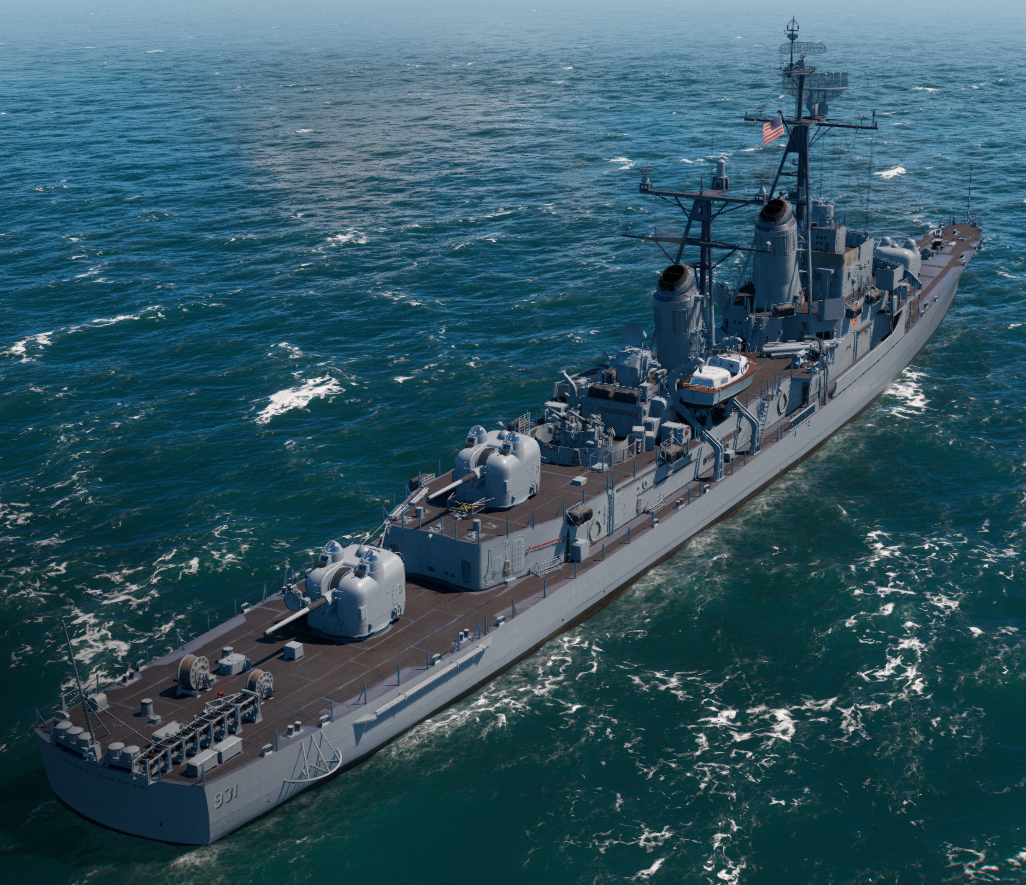
wow’s rendition
Construction
Nine ships were constructed by Bath Iron Works of Bath in Maine, Five were attributed to Bethlehem Steel, Fore River Shipyard (Quincy, Massachusetts), two at Ingalls Shipbuilding, Pascagoula (Mississippi) two at Puget Sound, Seattle (Washington) with hull numbers 931 to 951, with DD-934 skipped for the ex-Japanese ex-Hanazuki as a war prize, and the ex-German DD-935 (T35), DD-939 (Z39). The last ones, DD-927 to DD-930 were completed as destroyer leaders. From Decatur onwards (DD 936) the hulls had an increased freeboard forward, and the last seven from DD 945 onwards had redesigned bows. Unitary construction cost was $26 million, the cost spread on four fiscal years for the whole class. Interestingly, USS Turner Joy (DD 951) was launched in May 1958, one month later in June was launched DDG-2, USS Charles F. Adams.
Hull & general design
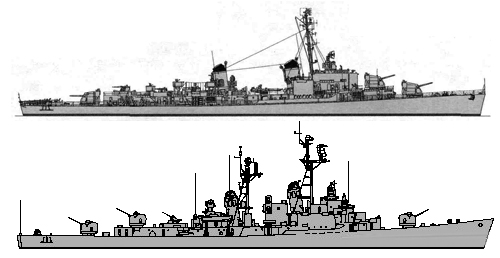
Comparison between a Gearing and a Sherman. Woth all discourses.
At the time they entered service, these ships were the largest US destroyers with 418 feet (127 m) long giving a 2,800 tonnes (2,800 long tons) displacement standard. Their hull still was the trademark flush-deck model of WW2, with a bit more flare, higher freeboard (further extended with sub-classes). At first glance, the general sihouette was very close, with low superstructures, two raked funnels, but longer forward and aft decks helped by the more compact turrets, and crucially, two solid tripods to support brand new, heavier radars, whereas the Gearings only has a single pole behind the bridge. Not built with extra simplification in mind, details were more refined and the covered bridge was provided with traditional windows instead of portholes and three-faceted for a better panoramic view.
Another particular of the hull was the adjunction of a hull-mounted sonar dome, and they all received updated sonar systems during their careers. USS Barry was the first to feature a bow dome, brand new in the U.S. Navy. Port and starboard anchors had to be eliminated because of this new feature, and a stem anchor adopted instead.
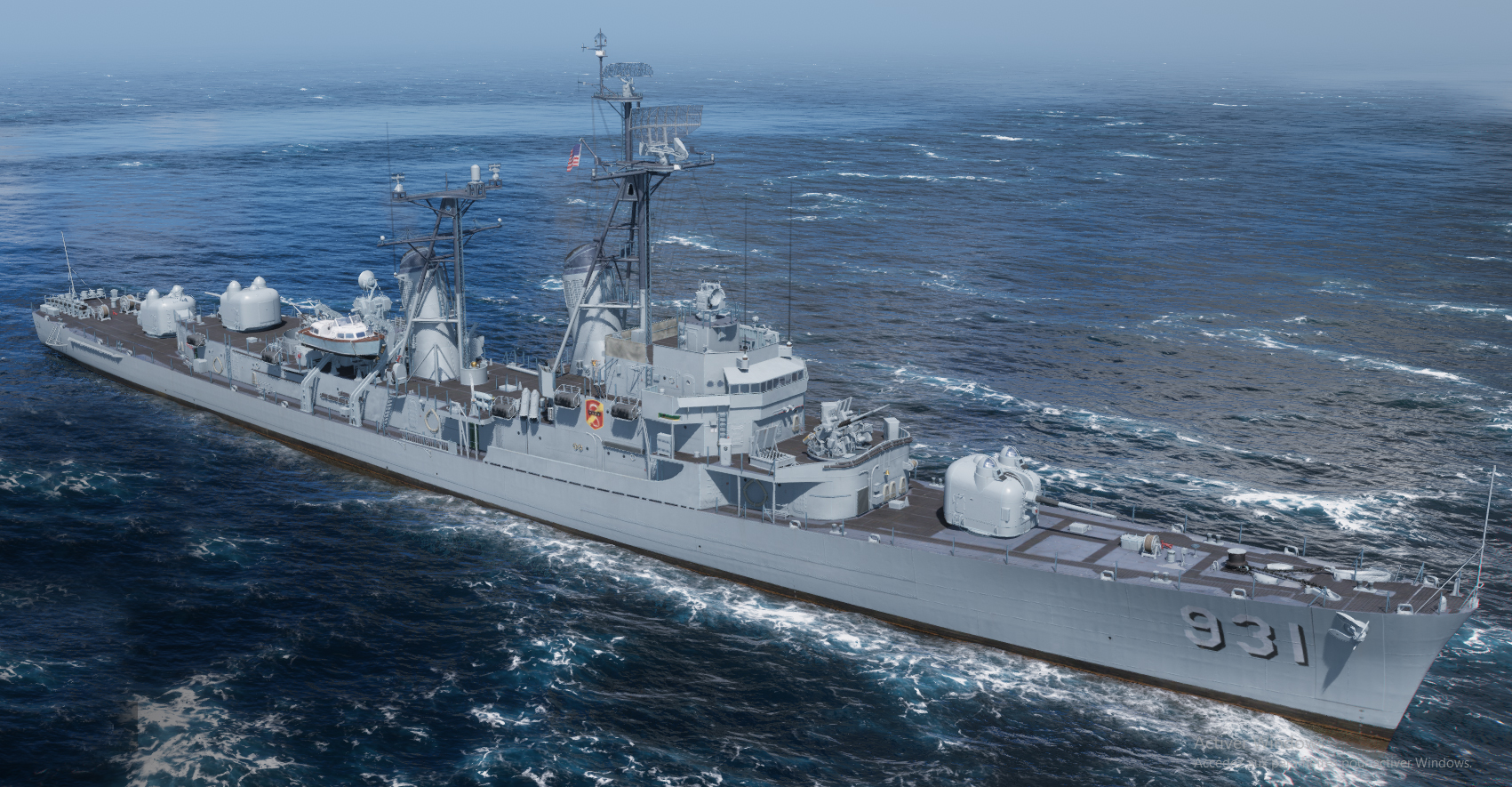
A 3D rendition of the USS Forrest Sherman as built, with the addition of a new enclosed bridge in front of the original bridge structure, soon after completion. Note the classic side anchors. To avoid problems with the underbelly sonar radome, later vessels were completed with an axial bow anchor instead (and the prow was raised also for better seakeeping). Click for HD.
Internal Arrangements
The Shermans were designed to accept accommodations for 315 rating and 22 officers and for this, the Bureau of Ships hired Lippincott and Margulies to study crew requirements, making design recommendations: Habitability was careful studied with arrangements and color schemes studied and detailed with a greater care ever paid for a destroyer design. There simply was more individual living area, better noise cushion as well as heat and vibration isolation.
Outside wartime, sleep quality was an important parameter for sailors to express their full potential during quarters. Each living space also has a small recreational area, separated from berthing, area, well provided with tables and chairs, crew bunks equipped with individual bunk lights and canvas containers for personal effects. Also for the first time, air-conditioning became mandatory. The messing space doubled as recreational space thanks to ingenious folding furnitures and strappings.
The galley and scullery were in a compact space onf the main deck amidships and the garbage disposal unit was conveniently located, with direct access to the sea. Accommodations in general were equally divided forward and aft with washroom and water closet spaces in separate compartments and in sufficient numbers and locations. Towel drying facilities, individual drawers for stowage of toilet articles were now available for the entire crew. The washroom inaugurated for the first time washstand with elbow operated spray heads, thermostatically controlled water. All these “delicacies” were seen by new ratings as a bonanza worthy of an hotel, and were seen with contempt (and envy!) by the old salt vets of WW2.
Powerplant & Performances
The Forrest Sherman class was no different than previous destroyers in terms of powerplant. It was virtually a repeat of the previous Gearing/Sumner, with two propeller shafts, driven by however two new General Electric steam turbines (to the exception of DD-931 which had Westinghouse turbines) fed by four Foster-Wheeler boilers (DD-937, DD-943, DD-944, DD-945, DD-946 and DD-948 had Babcock & Wilcox models) working at 1,200 psi (8.3 MPa), for a total of 70,000 shp (52 MW). This was 10,000 shp more than the Gearing class. DD931 and 932 had two Westinghouse steam turbines plus 4 Babcock & Wilcox boilers, DD933, 938, 943, 951 had two GE turbines, four B & W boilers, DD936, 937 two Westinghouse turbines, four Foster Wheeler (FW) boilers, DD940, 941, 942 two GE turbines, four FW boilers.
Top speed was 32.5 knots (60.2 km/h; 37.4 mph) however (Gearing 36.8) although one, Decatur, reached 35 kts on trials, and Range was 4,500 nautical miles (8,300 km) at 20 knots (37 km/h), the same as the previous class. Top speed was no longer a priority as defined in the 1951 specifications. The Farragut class would also be capped to 32 kts but the Charles F Adams would be rated at 33 kts. It should be noted that their 1970s modernizations included a partial overhaul of their machinery, upgraded to run on JP5 (jet fuel) rather than the traditional “bunker C” oil. This enabled for boost in performances, but degraded their machinery as well and contributed to their premature retirement.
Armament
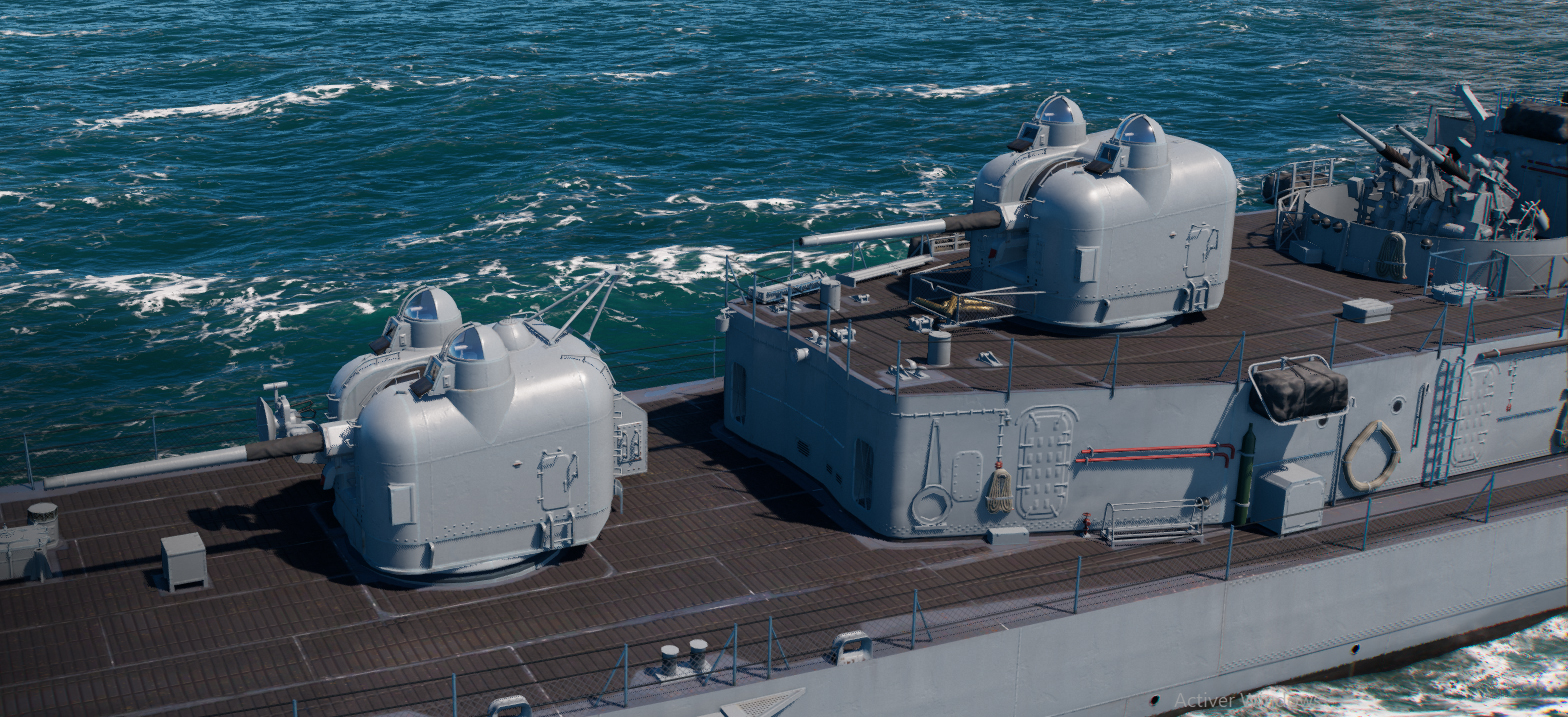
WoW’s rendition of the Forrest Sherman: Aft deck: Nice view of the two 5-in/54 showing notably their two firing posts, one for anti-shio and one for AA targeting. Behind on the quarterdeck is located the aft 5-in/54 mount.
Project SCB 85 included three 5-inch (127 mm)/54 caliber guns, single turrets, two twin 3-inch (76 mm)/50 AA, two hedgehogs forwars, and fixed 21-in torpedo tubes, plus a single rack at the stern for depht charges. Compared to the arsenal of a Gearing class in 1945, it appeared superficially weak: six 5-in/38, 3×4 and 2×2 40mm/60 Bofors, eleven 20mm/70, a quintuple 21-in TT bank, 6 DCR and 2 DCT (56 grenades). It was not the case. Whereas the 20 mm appeared useless against Kamikaze, Bofors were soon no longer adequate against the last generation of 700 kph piston engine models or early jets, and only four 3-in/50 AA could do the job quite well. The new 5-in/54 were infinitely superior to the twin mounts 38 caliber in velocity, rate of fire and accuracy. Great hopes were placed on new acousting torpedoes, negating the use of old-style traversing banks, and depht charges were well completed by hedgehog systems, more efficient.
Three 5-in/54 (127 mm) DP
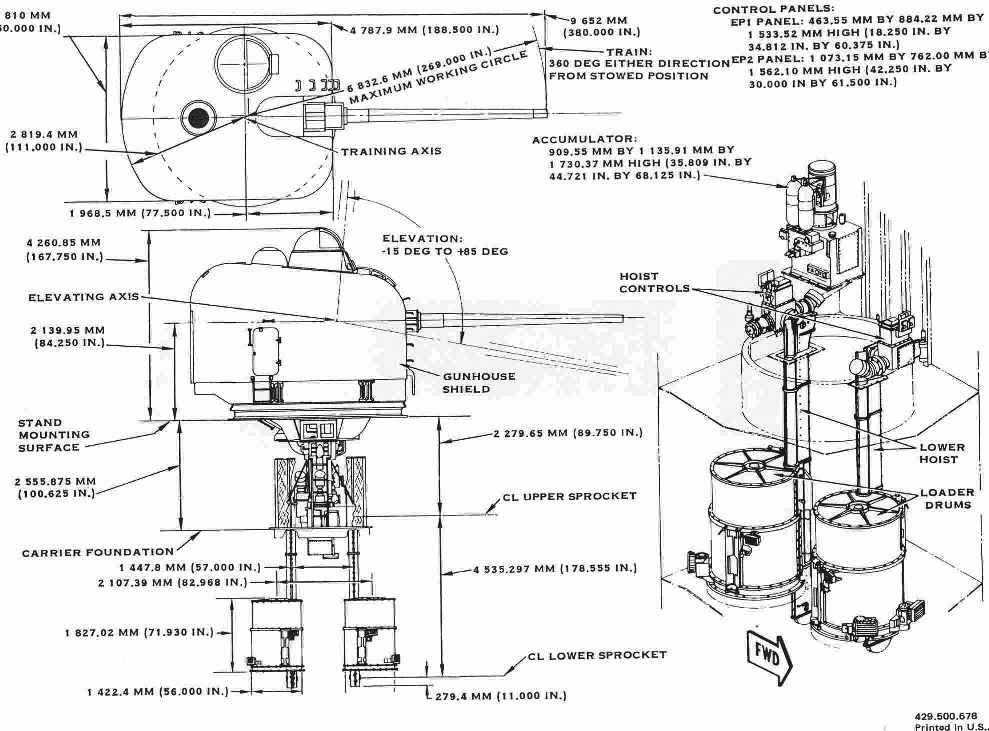
The Mark 42 5″/54 really was a cold war game changer for NATO. Not only it equipped cruisers, destroyers, frigates or the USN, but also was used by Australia, Egypt, Germany, Greece, Japan, Mexico, Spain, Taiwan, Thailand and Turkey, but it stayed in service amazingly well past the 1990s, staying relevant as long as the radar based firing control stayed relevant.
Performances:
-Shell 127 x 835mm .R Conventional 31.75 kg (70.0 lb)
-Recoil 18.75 inches (476.2 mm)
-Elevation -15°/+85° at 25°/sec
-Traverse 150° at 40°/sec
-Rate of fire 40 rpm automatic (28 in 1968)
-Muzzle velocity 2,650 ft/s (807.7 m/s)
-Max range 25,909 yd (23,691.2 m) at +45° elevation
-Ceiling 51,600 ft (15,727.7 m) at +85° elevation
Two twin 3-in/50 AA
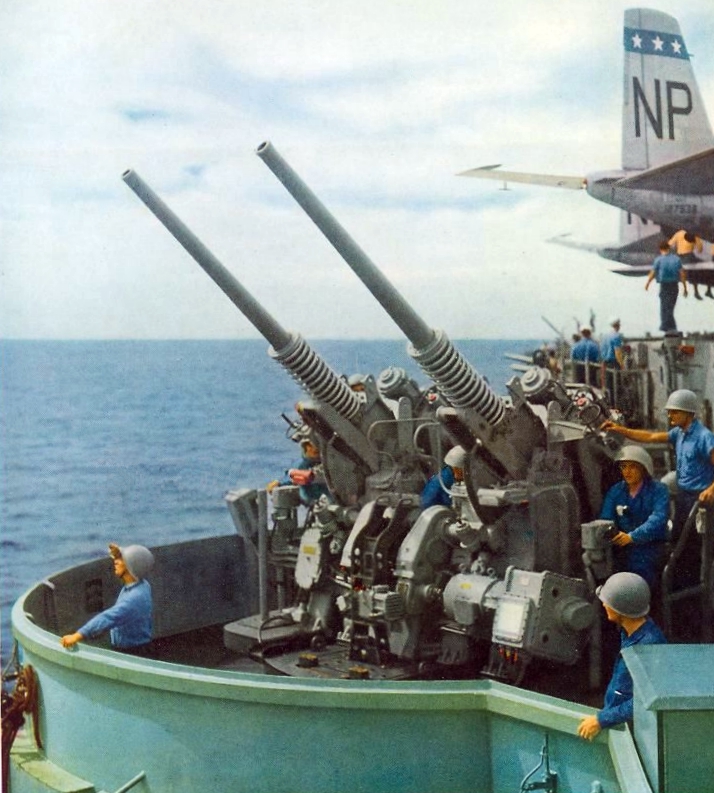
Designed to replace both the Oerlikon 20 mm and Bofors 40 mm guns to face kamikaze attack at short ranges the last ireration of the old 3-in in service since before WWI was fitted on a Mark 22 mount. Semiautomatic, with power-driven automatic loader, it was excellent but heavier than expected. Full traverse was done in 30° sec. elevation from 15 to 85° at 24°/s. The feed was assisted by two loaders.
Performances:
-Shell 12.13 in (30.8 cm)
-Weight Mark 31 Mod 1: 24 lbs. (10.9 kg)
-Elevation -15°/+85° at 30°/sec
-Traverse 360° at 24°/sec
-Rate of fire 40 rpm automatic (28 in 1968)
-Muzzle velocity 2,700 fps (823 mps)
-Antiship range (45°): 14,600 yards (13,350 m)
-AA ceiling (85°): 30,400 feet (9,266 m)
Two Mark 10/11 and later Mark 15 Hedgehogs
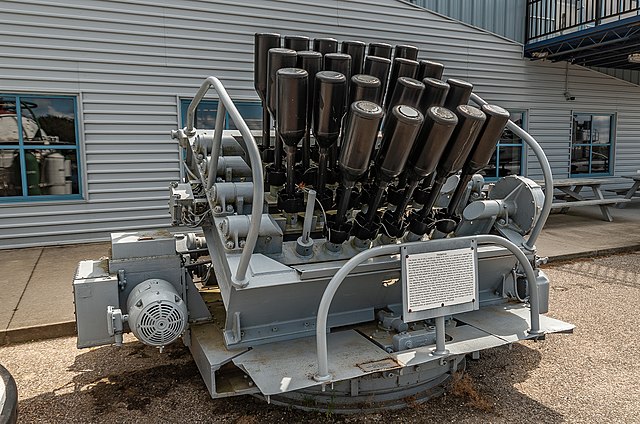
Mark 15 Hedgehog
Two Mark 10/11 early US Hedgehogs were mounted on the upper structure aft of the forward main turret, at the foot of the bridge. The Mark 10 and Mark 11 launched a pattern of twenty four Mark 6, 7.2-inch projector charges ahead. It equipped not only the Sherman class but also rearmed all active SUMNERs, GEARINGs, and FLETCHERs, either with the MK 10 or MK 11.
Not different from WW2 models it possessed a base frame, a blast shield, cradles and spigots, plus a roll correction gear assembly. The firing mechanism was located behind the blast shield. The carrying frame consisted in four longitudinal tilting cradles, each carrying six fixed spigots, all mounted with firing pins. They had charges fitted over the spigot, seating on the retaining nut of the firing pin. The charges made an elliptical pattern when entering the water, setup by changing their tilt angle, and fired electrically in pairs with 0.10 second intervals to avoid interference.
The MK 10 and MK 11 only differed in shape and projection distance:
Mk.10: pattern of 140 x 120 out at 200 yards
MK 11: Circular pattern 200 feet in diameter at 188 yards.
The MK 6 projector charge measured 7.2 inches (diameter) by 3.88 feet long and between 50 and 53 pounds.
A single sailor could reload all spigots in about 6 min, hence the need of two such hedgehogs, for 48 in all. Once the sonar had located the submarine with precision, the destroyer would rush forward and “frame” it with explosions, causing untold pressure damage.
It seems they were both replaced by Mk 15 Hedgehogs at a later date (photo). The Mark 15 became the Standard 1950s trainable Hedgehog mount with stabilization, power-trained by a remote fire control system. Total weight of the system was 17,425 lbs and it required a crew of eight, with a five minutes full reload. The pattern was 280 foot wide, delivered after 10.4 sec. flight and it took 18.6 seconds to sink to 200 feet (61 m), which was better than the previous Mark 11. Its mount was more complex and faster in both traverse and elevation than the Mark 10/11 and some destroyers mixed both types. The projectiles were the same, only the pattern changed.
However with time, the speed and depth of new generation submarines would made them obsolete and impose the use of acoustic torpedoes instead, by tubes or launched by missiles, such as the ASROC system of the 1960s.
21-in acoustic fixed TTs
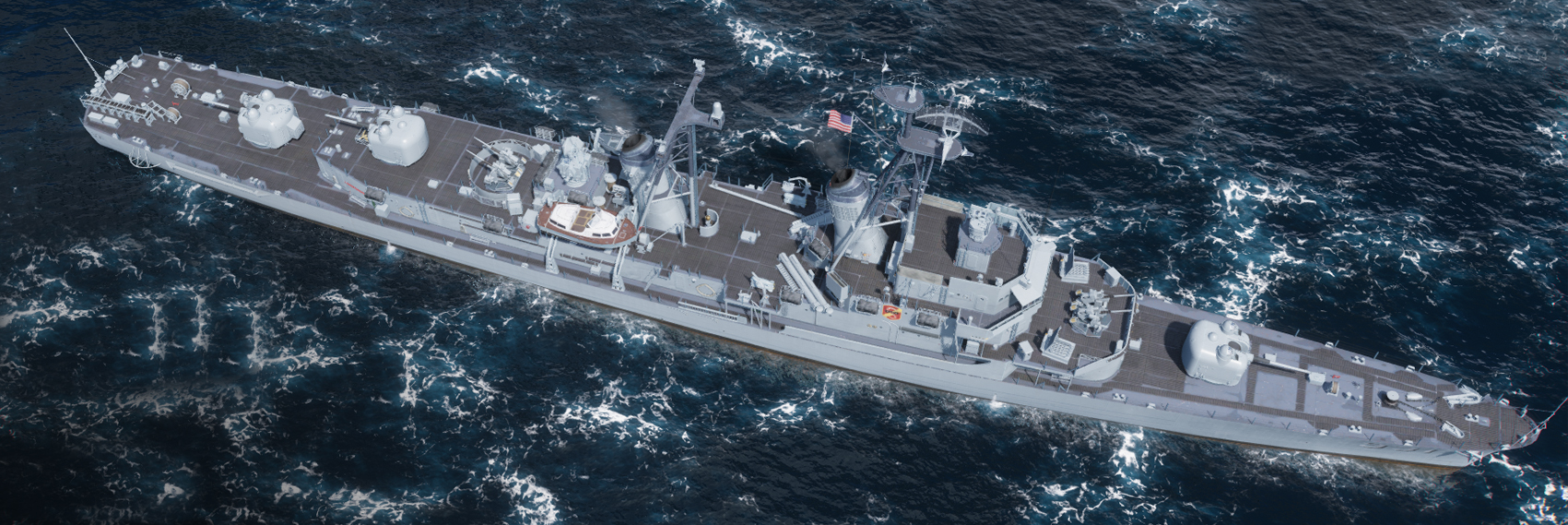
WoW’s rendition of the Forrest Sherman: Top view showing the location of the four fixes 21-in TTs, on the upper deck behind the bridge, at the foot of the foremast and funnel and angled 30° forward.
Another particular of this design was the use of new fixed torpedo tubes. Having a traversing mount made no sense with an acoustic torpedo since it’s heading can be modified on the way. Any tube angle could do therefore, allowing more leeway in placement on the ship and gain of space. The reloading was an issue however. On the Forrest Sherman class, they were located in two pairs forward, on the upper deck, apparently without reload.
There were also a one-off torpedo type, specifically designed for ASW warfare, unusual at this caliber as the standard would be later the 324 mm triple bank found on virtually all ships of the USN.
21″ (53.3 cm) Mark 35: This was likely the standard used on the Forrest Sherman class.
It was Design from 1946, entered service in 1949. It Weighted 1,770 lbs. (803 kg) for 13 ft 5 in (4.089 m) long, carrying an xplosive Charge of 270 lbs. (122.5 kg) HBX at 15,000 yards (13,710 m) at 27 knots using an electric-Battery cooled by seawater and guided by Active and passive acoustic spiral search. It could be used against ships as well.
With about 400 produced between 1949-1952 it was replaced from 1960 by the Mark 37. Settings came from a fire control system through a 1″ (25 mm) diameter umbilical cable, cut away with the expulsion from the tube. It can use either a pre-enable run-out course and distance, or various searching patterns in all directions.
Sensors
Radar SPS-6

The AN/SPS-6 was a 2D radar from Bendix and Westinghouse Electric, used by the US Navy as a first-generation air-search radar after the war. It was also widely exported to allies and NATO in the 1950s. The AN/SPS-12 was a derivative types made in other countries. The SPS-6 (entering service in 1948) used a L Band Frequency, had a 130 – 260 km (70 – 140 nmi) range, and was powered by 500 Kw. It was replaced by the SPS-10, SPG-53A and Mk 35 radars with the DDG conversion.
Sonar SQS-4
The AN/SQS-4 was a long-range active/passive, search and attack sonar. It was the first of such types designed after the war, and the basis for all following US sonars. It had an operating frequency of 14 KHz with selectable pulse lengths from 6 to 30 and 80 milliseconds based on outputs of 50, 30, 10 kW, with range scales from 1,000, 2,500, 5,000, 10,000, to 15,000 yards (corresponding to 914, 2,286, 4,572, 9,144, and 13,716 m). It was physiaclly traduced by a radome built under the hull, located at the position of the forward 3-in AA gun. Dedicated ASW conversions had brand new SQS-23 and 35 Sonars.
Mark 56 Fire Control System

The standard FCS coupled with the 5-in AA guns. This gun fire-control system combined the AN/SPG-35 radar tracker and Mark 42 ballistic computer. It has a classic dish-like antenna and small cabin for the operator. The Forrest Sherman had two of them, installed on top of the bridge and aft the second funnel. The radar associated worked on X band with a PRF of 3,000 pps, Beamwidth of 2, Pulsewidth of 0.1-0.15 μs, 27 km (14.6 nmi) range with a 9m precision (10 yd), and working on 50 kW. It was introduced in 1954 and installed nearly on all USN gun-armed ships, in service also during the Vietnam war. The Mk.68 GFCS was the standard associated with the Mark 42 5″/54 cal gun, using a secondary directional board.
Modernization & Evolution
Jet aircraft development in the 1950s however soon made this a main anti-aircraft armament ineffective against airborne nuclear attacks and new supersonic jets, plus missiles. The AAW package was completely obsolete in the early 1960s.
Already edgehogs and 3-inch (76 mm) guns were removed in the sixties and up to the early 1970s as the fixed torpedo whereas two triple 12.75 inches (324 mm) Mark 32 torpedo tube mounts replaced them for ASW warfare. This was just a “basic” upgrade, but complete reconstruction planes were also drafted to prolongate their service until the 1980s.
As attention shifted in 1955 to development of effective surface-to-air (SAM) systems the Forrest Sherman were already replaced by DDGs, new frigates were studied as the ten Farragut class as Ocean escorts or destroyer leaders, true predecessors of missile cruisers. The Charles. F. Adams were essentially enlarged Forrest Sherman and the admiralty wanted the Forrest Shermans gradually converted by mid 1960s to either guided-missile destroyers (with Tartar SAM/ASROC) and for budget concerns, eight additional as ASW vessels with updated weaponry between 1967 and 1971. They were updated to stay active until the end of the cold war in 1990 but were retried in 1982-83 more because of their high-pressure engine than obvious obsolescence, compared to the Spruance class in particular.
SBC-85:
The original design with the armament described above.
SBC-85A:
Hedgehogs, 3-inch AA guns, fixed torpedo tubes removed. 2×3 12.75 inches (324 mm) Mark 32 torpedo tube mounted. This was done as construction proceeded for the last batches, and fire control directors were reversed from the SCB 85 configuration while a new B&W Bailey Meter automatic boiler combustion control system was installed, modified hurricane bow/anchor. Some authors had them sub-classed a “Hull-class destroyers”.
SCB 240 (DDG conversion):
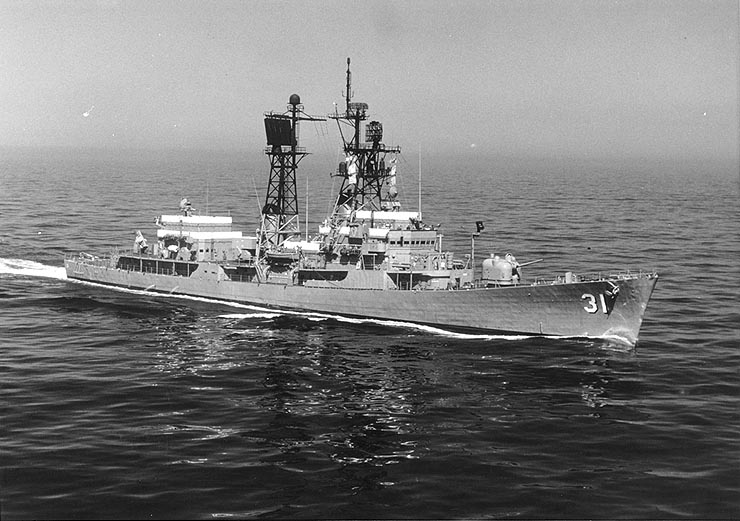
USS Decatur after conversion as DDG-31. Being the first converted, as a prototype, the SBC 240 is also called “Decatur class” in most publications.
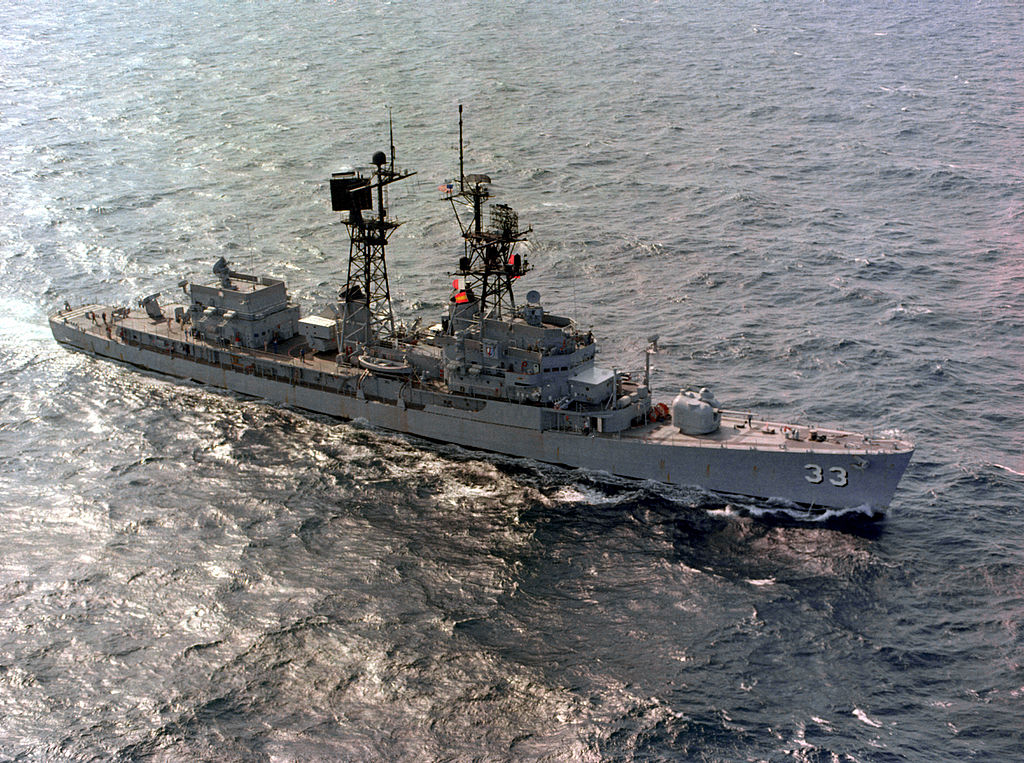
USS Parsons in the 19740s after her overhaul and DDG conversion
The most important upgrade, performed in 1966-67: USS John Paul Jones, Parsons, Decatur, and Somers became guided-missile destroyers with Tartar missiles, new radars and FCS, new derrick masts. This upgrade diverged in small details: USS Decatur and John Paul Jones had in standard a single Tartar SAM (40 RIM-24), an octuple ASROC ASuR (16 RUR-5), single 127mm/54 Mk 42 turret left forward, two triple 324mm Mk 32 TT, and the SPS-29, SPS-40, SPS-48, SPS-10, SPG-51C, and SPG-53B radars. They made the swap to the SQS-23 sonar and in complement gained the WLR-1, WLR-3, ULQ-6 ECM suites. Same for USS Parsons with the exception of a SPS-48 radar instead of 40. USS Somers combined the SPS-40 and SPS-48, the rest was identical.
SCB 251 (ASW Modernization):
Eight remaining vessels, USS Barry, Davis, Jonas Ingram, Manley, Du Pont, Blandy, Hull, and Morton also known as the “Barry class” were fitted with ASROC launcher and a variable-depth sonar system. Six others were planned but due to the Vietnam War budget constraints had them cancelled. The conversion was made between 1967 and 1971. USS Barry, Davis, Manley were the first converted to ASW destroyers: They were rearmed with an octuple ASROC ASuR (20 RUR-5) in place of their N°2 turret, two remaining, but two triple 324mm Mk 32 TT, two 24x178mm Mk 15 Hedgehog ASWRL remaining forward, One DCR aft. Electronics suite was modernized wit the SPS-37, SPS-10 and SPG-53A radars, but also the SQS-23 and SQS-35 sonars. Countermeasures comprised a WLR-1, WLR-3 and ULQ-6 ECM suites. The second batch converted at the same time concerned USS Jonas Ingram, Du Pont, Blandy, Morton, Richard S. Edwards with the same, but the SPS-40 radar instead of SPS-37.
In a general way, other destroyers were upgraded during the same period: Forrest Sherman and Hull lost a twin 76mm/50 and gained a SPS-40 radar and SQS-23 sonar. USS Turner Joy had the same but kept her two AA 3-in mounts, as USS Bigelow that had a SPS-37 radar instead, like USS Edson (One 3-in mount). USS Mullinix had the SPS-12 radar.
8″/55 Mark 71 gun test:

USS Hull (DD-945) became a test platform with a prototype 8″/55 caliber Mark 71 light-weight gun. This was an attempt to reintroduce naval artillery on US ships with the experience of Vietnam, to dispense from keeping costly conventional vessels. Tese were performed from 1975 to 1978. But performances were disappointing and the program was canceled, the 5-inch mount was restored. USS Hull however became the only destroyer in history to have sported in service a heavy-cruiser 8-inch (203 mm) gun.
Active Service and General Assessment
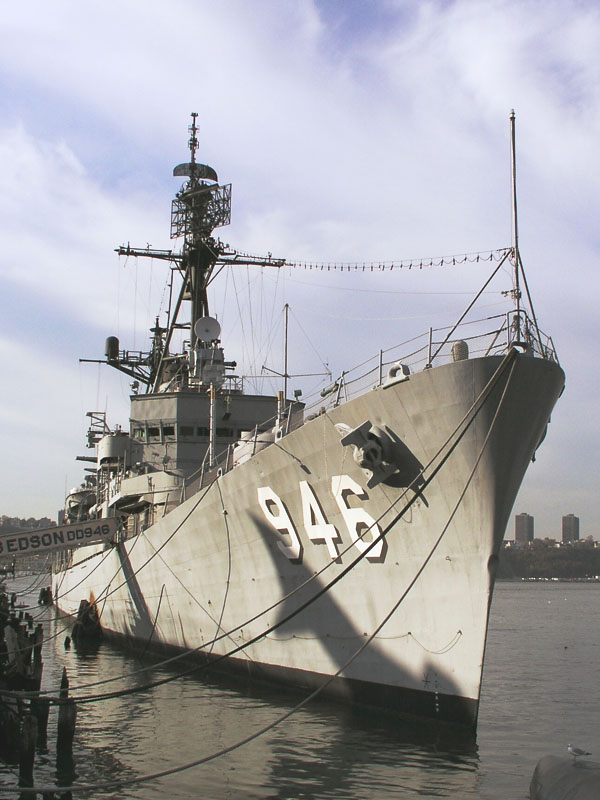
The Forrest Sherman–class destroyers entered service between 1955 and 1959 and assigned to all task forces across the globe (Atlantic, Pacific, Indian ocean, Persian Gulf, Mediterranean…). Most made a tour of duty in Vietnam as part of the “gunline”, shelling various shore targets in North Vietnam. USS Turner Joy was there from the start, involved on the Tonkin Gulf Incident, an alleged NVA attack by in August 1964. All named after distinguished servicemen died in WW2, they were christened by their widows and some by descendants. The service routine was always about the same: Initial yard trials, official ones, shakedown cruise and initial training between the Caribbean and South African coast. Service in the Atlantic, North Sea, Mediterranean, and/or Pacific punctuated by fleet training, goodwill and recreational port calls, repair and overhaul and some rescue missions.
The entire class was decommissioned in 1982-1983, despute the upgrades of twelve ships. This was not due to obsolescence but chronic problems with their high-pressure steam engines. Only USS Edson was used for training until 1988. Four were placed in reserve and struck at the end of 1990, nine sunk as targets, five scrapped, three preserved as museums, but Forrest Sherman was eventually scrapped in 2013, leaving only USS Edson in Bay City, Michigan, and USS Turner Joy since 1991 in Bremerton, Washington, east coast.

Author’s profile of the class. A DDG conversion and an ASW conversion profiles are awaited.
⚙ specifications |
|
| Displacement | 2,800 tons standard, 4,050 tons full load |
| Dimensions | 127 x 14 x 6.7m ( 407wl/418oa x 45 x 22 feets) |
| Propulsion | 2 shafts GE/Westinghouse steam turbines, 4 Foster-Wheeler/B&W boilers 70,000 shp (52 MW) |
| Speed | 32.5 knots (60.2 km/h; 37.4 mph) |
| Range | 4,500 nautical miles (8,300 km) at 20 knots (37 km/h) |
| Armament | 3×5 in/54 Mk42, 4×3 in/50 Mk33, 2×24 Mk10/11 Hedgehogs, 4×21-in TTs |
| Sensors | Radar SPS-6, Sonar SQS-4, Mark 56 FCS |
| Crew | 15 officers, 318 enlisted |
Read More
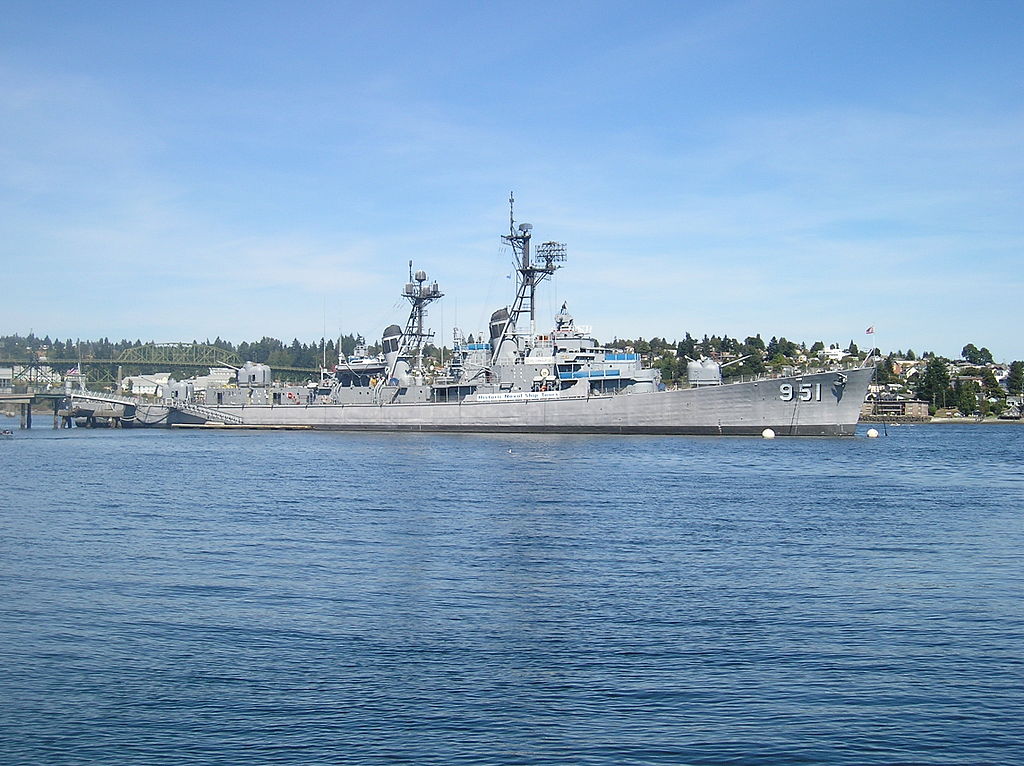
USS Turner Joy, one of the two destroyers of this class that can be visited today. She is berthed in Bremerton, Washington state on the west coast.
Books
The Life and Ships of William Francis Gibbs, 1886–1967 (New York: Gibbs & Cox, 1968), 183
Fahey, James C. (1965). The Ships and Aircraft of the United States Fleet, 8th Edition. NIP.
Friedman, Norman (1982). U.S. Destroyers: An Illustrated Design History. USNI
Links
https://destroyerhistory.org/coldwar/forrestshermanclass/
https://tile.loc.gov/storage-services/master/pnp/habshaer/dc/dc1100/dc1148/data/dc1148data.pdf
https://en.wikipedia.org/wiki/Forrest_Sherman-class_destroyer
https://www.navypedia.org/ships/usa/us_dd_forrest_sherman.htm
https://www.destroyers.org/tcs-ships/ordnance-photos-and-articles/the-mark-10-11-hedgehog-projector/
http://www.navweaps.com/Weapons/WAMUS_ASW.php
http://www.navweaps.com/Weapons/WTUS_PostWWII.php
https://www.seaforces.org/usnships/ddg/Decatur-class.htm
https://www.seaforces.org/usnships/dd/Forrest-Sherman-class.htm
https://www.loc.gov/pictures/item/dc1148/
Model Kits

Since they were cold war destroyers, not much, but the quirky old 1:319 Revell kit dating from the time these ships were just introduced. Revell also made USS decatur and John Paul Jones. Full list. Apart Revell, Iron Shipwrights 1:350, JAG 1:700, others were below 1:1200 scale. We still find for fans of hyper-detail USS John Paul Jones and Morton by The Scale Shipyard at 1:96… But they are old and hard to find. Model Monkey also developed 3D printed parts, in 1:350 and 1:700, or the main guns, Mk.56 FCS and even USS Hull’s 8-in/55 Mk.71. Happy modelling !
Career of the Forrest Sherman class
Of the 18 completed, nine were disposed of in fleet training exercises (as target ships), seven were sold by the new Defense Reutilization and Marketing Service (DRMS) agency to be recycled and scrapped, and two became museums.
 Forrest Sherman (DD-931)
Forrest Sherman (DD-931)
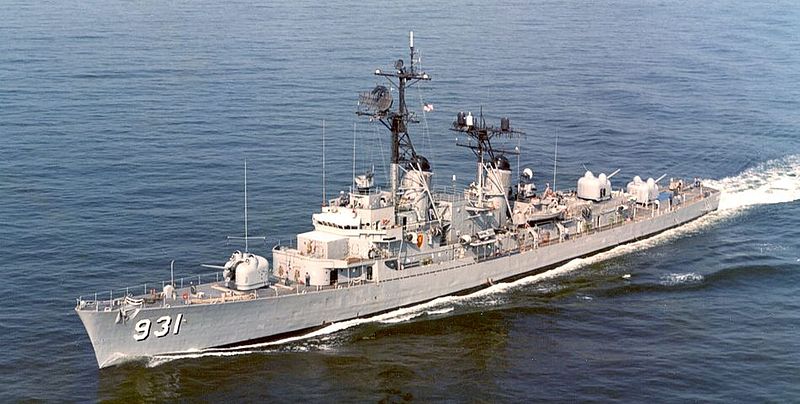
USS Forrest Sherman in 1978, after modernization
USS Forrest Sherman was baptised at Bath Iron Works (Bath, Maine) on 5 February 1955 by Mrs. Forrest P. Sherman, widow of Admiral Sherman. She was commissioned on 9 November 1955 and needed a year of initial training and fitting out plus shakedown cruise and fixes. She arrived at her first home port, NAS Newport in Rhode Island o, 15 January 1957. She sailed to Washington, D.C., opened for a week of public visits during the visit of President Dwight D. Eisenhower. Next she took part in fleet exercises along the east coast and Caribbean and midshipman cruise to South America plus the Naval Review in Hampton Roads on 12 June.
On 3 September 1957, she took part in NATO Operation Strikeback screening a carrier striking group off Norway. She also stopped in Plymouth and Copenhagen, back home on 22 October. She covered amphibious exercizes off Puerto Rico in July 1958, and proceeded to Gibraltar on 10 August, patrolling the eastern Mediterranean and through Suez joined the 7th Fleet off Taiwan due to the Quemoy and Matsu crisis. She went on eastwards and arrived on the Califirnian coast, through Panama, closing her first world cruise when arriving in Newport on 11 November.
The summer of 1959 saw her in Operation Inland Seas in the Great Lakes, and celebrating the opening of the St. Lawrence Seaway. She also escorted the Royal Yacht HMY Britannia with President Dwight D. Eisenhower and Queen Elizabeth II aboard, touring the Great Lakes ports. She took part in more coastal exercises with the Atlantic Fleet and went in maintenance at the Boston Naval Shipyard.
1960, 21 March saw her taking on a 7-month cruise and duty tour to the Mediterranean with the 6th Fleet. While back home in October, she recued a badly injured sailor of Liberian freighter Allen Christensen. After this she entered Boston Naval Shipyard for a major overhaul until late 1961. The rest of her career is being reconstructed from logs (not accessible) by DANFS fopr .history.navy.mil. Stay tune for updates. She was further modernized in 1966 and took part in Vietnam Operations.
Forrest Sherman was decommissioned on 5 November 1982, stricken on 27 July 1990, sold for scrap to Fore River Shipyard (Quincy, Massachusetts) on 11 December 1992 but as the latter went bankrupt, to N. R. Acquisition Incorporated NYC. She was berthed by the Navy in the Inactive Ship Facility at Philadelphia Naval Shipyard then listed for museum donation. In 2006, it was authorized by Congress to a Foundation planning to have her moved to Indian River Inlet in Delaware for restoration. But it never secured the funds and the ship was expelled from the donation hold in 2011, cannibalized by volunteers in June 2011 and resold sold (3rd time !) on 15 December 2014, to the Defense Logistics Agency Disposition Services.
 John Paul Jones (DD-932)
John Paul Jones (DD-932)
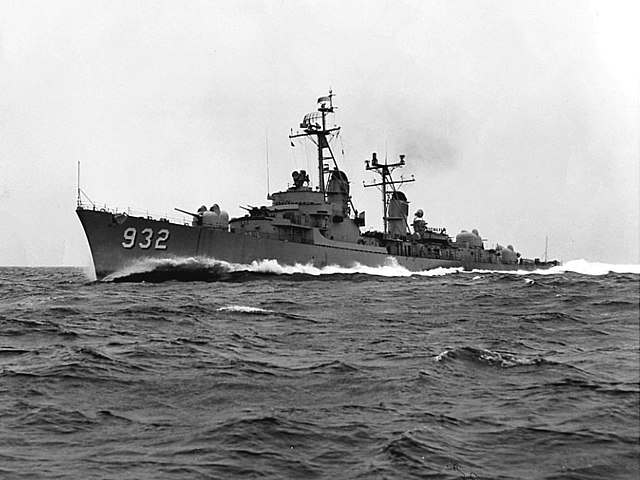 USS John Paul Jones (DD-932 ) underway at high speed while running sea trials off the New England Coast, 25 March 1956. She was commisioned on 5 April 1956 at Boston. Official U.S. Navy Photograph, from the collections of the Naval History and Heritage Command.[/caption]
USS John Paul Jones (DD-932 ) underway at high speed while running sea trials off the New England Coast, 25 March 1956. She was commisioned on 5 April 1956 at Boston. Official U.S. Navy Photograph, from the collections of the Naval History and Heritage Command.[/caption]
USS John Paul Jones, second of the initial class destroyers of post-war design, conducted exhaustive shakedown training out of Guantanamo Bay, Cuba, after which she departed for a cruise to Northern Europe and the British Isles. During this voyage Commander Hayler and members of the crew visited the birthplace of John Paul and presented the ship’s emblem to the people of Kirkcudbright. She returned to her home port, Newport, 8 October 1956.
The new destroyer departed for her first cruise with Sixth Fleet 25 March 1957. In May she took part in an operation in support of King Hussein of Jordan. After successfully averting his overthrow, John Paul Jones sailed for Newport once more, arriving 6 June 1957. NATO maneuvers in the North Atlantic followed in October. After another brief cruise to the Mediterranean, she arrived Fall River 27 November and in January 1958 she took part in fleet exercises in the Caribbean.
In the spring of 1958 John Paul Jones operated with Canadian ships on training maneuvers in the Atlantic. After further training off the East Coast and in the Caribbean, she sailed again for the Mediterranean 17 March 1959. This tour with the 6th Fleet on its peace-keeping mission ended 24 July when the ship arrived Boston.
The year 1960 began with 2nd Fleet operations out of Newport, and in June the destroyer embarked midshipmen for a training cruise. She then departed 22 August for a cruise to South America. As part of Operation Unitas, she circumnavigated the continent, visiting many of America’s southern allies and taking part in joint exercises with their navies.
After transiting the Straits of Magellan and the Panama Canal, John Paul Jones returned to Newport 13 December 1960. During 1961 and 1962 the ship carried out antisubmarine exercises in the Caribbean and out of Newport. In April 1962 she took part in a fleet review and weapons demonstration for President John F. Kennedy, and in July she again embarked midshipmen for training. In October 1962 the ship was on station with the Atlantic Recovery Forces during the orbital flight of Commander Wally Schirra, and soon afterward moved off the coast of Cuba during the Cuban Missile Crisis. The following year saw the veteran ship embark on another Mediterranean cruise 6 February to 1 July; the remainder of 1963 was spent on antisubmarine exercises in the Atlantic.
Operations along the Atlantic Coast continued until John Paul Jones began another 6th Fleet deployment 20 June 1964. She operated primarily in the western Mediterranean, on ASW assignments until returning home 3 September 1964. Early in 1965 she participated in Operation “Spring board” in the Caribbean. In March the destroyer received a Gemini-recovery crane and on the 19th sailed for her recovery station some 200 miles south of Bermuda. She was to pick up astronauts Major Virgil Grissom and Lt. Cmdr. John W. Young and their space craft in the event that they ended their flight after two rather than the three scheduled orbits. However, all went well so she returned to Norfolk 27 March without headlines.
John Paul Jones headed back to the Mediterranean 18 June for NATO exercises with units of the French, Greek and British navies. John Paul Jones was converted to a guided missile destroyer at the Philadelphia Naval Shipyard between 20 December 1965 and 15 March 1967 and designated DDG-32. Her story after this is still documented from original logs (work in progress). She was stricken on 30 November 1985.
 Barry (DD-933)
Barry (DD-933)
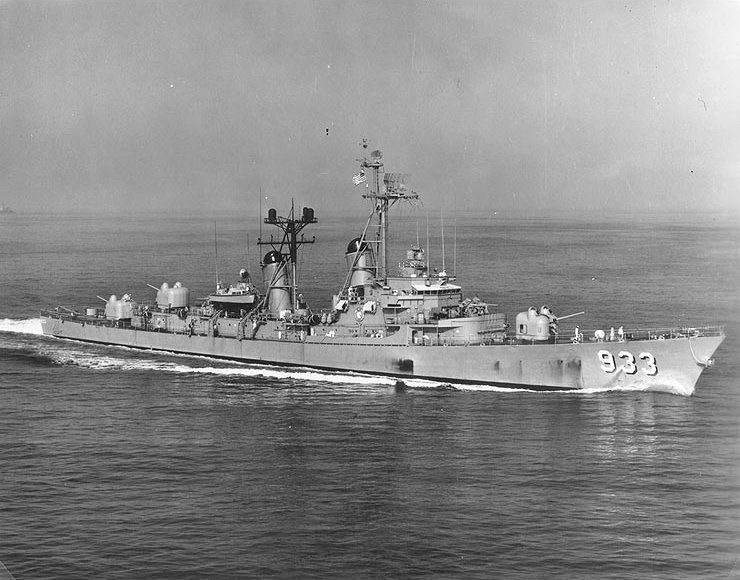
USS Barry in 1960
USS Barry was built in Bath, Maine, was launched on 1 October 1955 and sponsored by Mrs. Francis Rogers, great-grandniece of Commodore Barry, commissioned at the Boston Naval Shipyard in Charlestown on 7 September 1956 with Commander Isaac C. Kidd, Jr.,in command. After fitting out and first trials and tests up to November-December she made a short cruise in Narragansett Bay, and on 3 January 1957 started her shakedown cruise for Guantánamo Bay in Cuba, stopping in Kingston, Culebra, Santa Marta, and Colón in Panama to transit for the Pacific on the 26th.
After a stop at Salinas in Ecuador, she made three goodwill visits and arrived on 5 Match to Callao, Peru, hosting the US Ambassador and City Prefect, heading afterwards to Valparaíso, before being called by the CiC of the Chilean Navy, Vice Almirante Francisco O’Ryan, hosting him and the consul and Commandant of the First Naval Zone. After refueling she left Valparaíso on 17 March for Panama, crossing on 23 March, and arrived in Boston on the 29th for post-shakedown fixes.
Overseas service 1957-64
On 15 May she left for exercises off New England and departed for Rosslare in Ireland, visiting also St. Nazaire, Lisbon, Gibraltar (16 July) to join the 6th Fleet as a carrier escort and plane guard, ASW barrier patrols. She was back in Rhode Island in August 1957 and on 24 September, after upkeep, she assisted the Norwegian freighter Belleville, aground off Seal Rock, Narragansett Bay. She escorted the SSN USS Seawolf, hoting President Dwight D. Eisenhower off Newport. After ASW exercises, plane guard operations with USS Forrestal and Leyte, she was prepared for the Mediterranean in May 1958, sailing out in June and crossing Gibraltar for Rhodes. With the 6th Fleet she took part in ASW exercises but on 14 July a coup in Baghdad led to a republic in Iraq and Lebanese government fearing a Pan-Arab insurgency requested troops to stabilize the situation. President Eisenhower honored it and sent the Marines in Lebanon.
USS Barry was thus sent in Salonika, Greece on 15 July with USS Saratoga in support, patrolling the Lebanese coast and assisting the Marines ashore. After a stop in İzmir, and Augusta Bay in Sicily, she departed for hom on 17 September, Boston for alterations and installation of a bow-mounted SQS-23 sonar. She spent the rest of the year in ASW tests and tactical trials. In January-May she was back to East Coast operations. In 1960 she made a summer goodwill tour in Northern Europe, with sonar demonstrations, calling Portsmouth and Kiel but also the Netherlands, Finland, Sweden, Denmark, and Belgium, training with NATO submarines, ending with French and Portuguese SSNs. After a stop in Montreal she trained off the Virginia Capes from 9 January 1961, integrated into a hunter-killer exercise. Se took part in amphibious exercises, returned to Boston for upkeep and made a new 1962 TOD in the Mediterranean with USS Randolph when recalled for the Cuban Missile Crisis.
In October 1962, Barry left Newport to take part in Cuba’s quarantine with USS Blandy, Charles S. Sperry and Keppler as part of TF Essex, detached for ASW surveillance and tracking Soviet (Foxtrot-class) sub C-19, surfaced and submerged, and went on patrolling until 8 November. She refuelled to Essex, and embarked by highline transfer a photographic and interpreter group to investigate a Soviet merchantman on the 9th. This was the Soviet-registry Metallurg Anosov. She photographed her deck cargo and went back to Essex to refuel and briefing.
She left the area for upkeep on 15 Nov. and resumed training down south to Santo Domingo and San Juan. She trained in ASW warfare for the next six months and from June 1963, an overhaul. She was back to the eastern seaboard with midshipmen brought to New York and Halifax, and meeting a hurricane off Bermuda.
1964 was the similar routine but she rescued the ship Antares, which erupted in flames, managing to extinguish it after a 18-hour battle. Next she was in a NATO exercise with the Bundesmarine in the Atlantic. After preparations in 1964 she was back in the Med. for 3.5 months. She also headed for the Norwegian Sea and crossed the Arctic Circle in September. She stopped in Valencia and Barcelona, Palma, Marseilles, Toulon, Naples, and took part in NATO Ops “Teamwork”, “Masterstroke”, and “Steel Pike I”. The next year after her spring training exercises she took part in the search for Gemini 4. This summer she also won her first Battle Efficiency awar (“E”) for ASW and was prepared for her first Western Pacific deployment as flagship DesRon 24. It was the first Atlantic group to be deployed in Vietnam, with USS Samuel B. Roberts, Charles S. Sperry, Hawkins, Vesole, and Ingraham in September, escorted by USS Harold J. Ellison and Bache.
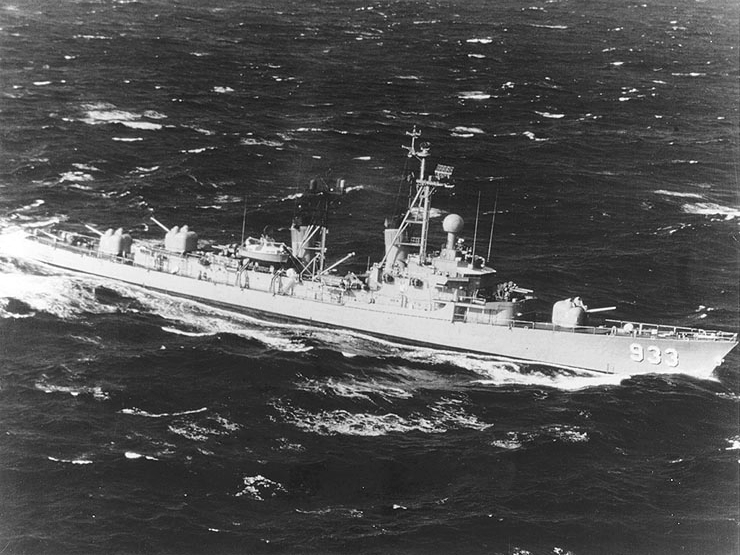
Vietnam War 1965-67
After a stop in Hawaii and Midway, Yokosuka and Sasebo, she reached Subic Bay as operating base, on 17 November 1964, commencing training at the Tabones Naval Gunfire Support Range. She later joined TG 77.7 (USS Enterprise, the missile cruiser USS Bainbridge, and destroyer USS Samuel B. Roberts, for “Point Dixie”, South Vietnam. She covered airstrikes on Bien Hoa. Barry was also detached for gunfire support and steamed up the Saigon River near Vũng Tàu on 7 December, deleting supply points and entrenchments and went on the Mekong Delta area for more off Cho Phuoc Hai, eventually spending 1,500 main guns rounds.
TG 7.77 then moved off Da Nang at “Point Yankee” for more strikes. After a short Xmas thruce, operations resumed on January 1966 until the force retired at Subic Bay foir upkeep and resplenishment.
She was after a crew’s leave recalled for “special operations” in South Vietnam, attached to III Marine Amphibious Force, providing naval gunfire coverage for these 5,000 Marines around Duc Pho on 28 January. It was the largest combat assault since Inchon. Operation “Double Eagle” was a success, well assisted by Barry, and USS Oklahoma City.
On 5 February, she covered the 1st Cavalry and ARVN units for Operation “Masher-White Wing”, spending 700 rounds before leaving for a rest in Hong Kong. She would eanr two battle stars for her Vietnam service. After being reunited with DesRon 24, she sailed for Penang in Malaysia, refueling, stopping in Singapore, Cochin in India, Aden, Suez, Naples, Barcelona, Gibraltar, Ponta del Gada and back to Newport for a first “globnav” on 8 April 1966.
ASW Overhaul and 1970s service
She trained in the Atlantic with DesRon 24 and was prepared in Boston Naval for her main overhaul but testing MK-86 GFCS with its AN/SPQ-9 radar. The latter was a brand new experimental optical pulse-compression radar, assorted with a new gun platform. She also received an upgraded SQS-23 and spent two months off Newport testings, going to the Carribean and NAS Florida, then off Jacksonville. She returned to Boston on 4 January 1967 for her main overhaul, full ASW conversion, with a VDS ASROC, new CIC and enclosed bridge, new propulsion and electrical systems, fully Recommissioned 19 April 1968 with Thomas H. Sherman in command.
On 26 May 1969, she made a six-week Caribbean cruise for tests and weapon calibration, refresher training up to Maine. She was asigtned to Yorktown ASW Group for European waters, North Atlantic’s NATO exercises and Arctic Circle operations, stopping at Antwerp, Oslo, Bergen, Le Havre. She also rescued the crew of a disabled helicopter. For two years apart a run to Greece in October 1970 (Jordanian-PLO conflict) she was in exercizes routine. Her home port was changed to Athens, Greece for the next decade. She joined the 6th Fleet at Rota in Spain and was in Athens on 1 September, DESRON 12 (USS Sampson, Richard Byrd, William Wood, Manley, Vreeland). NATO exercises with the Greek Navy and Turkish navy plus goodwill visits she tracked a surface Soviet Foxtrot-class on 11 January 1972.
In 1973 she had her AN/SQS-23 updated in Athens. She was prepared for an ASW screening of the Marine Landing Battalion answering a Soviet naval buildup as the 1973 Arab–Israeli war started. A Marine CH-46 helicopter in a routine flight crashed into her ASROC deck. Damage was light and there was no injuries, but the helicopter’s crew, two being rescued. Her carrier escort mission went on until the end of the year.
She assisted the Greek fleet during the Cyprus Crisis, evacuating 50 military personnel from Athens to Naples and was back to the Aegean, tracking Turkish moves under command of Admiral James L. Holloway, later taking part in NATO Exercise “Sardinia 75”, later leaving Athens as the naval station agreement was revoked. She later stopped in Villefranche-sur-Mer, Palma de Mallorca and Rota before reaching Philadelphia on 20 August, later receiving the Arleigh Burke award fom Admiral Isaac Kidd her first CO. In 1976 she made a three-week ASW training off Rhode Island before a major overhaul in Philadelphia since 1968.
She left drydock on 9 February 1977 for sea trials and was assigned to NAS Mayport in Florida in March, making afterwards a 5th deployment to the Mediterranean with CAG USS America by September 6th Fleet. On 10 November she assisted the rescue of two ditched airmen from USS America. She visited Dubrovnik, and Naples, Villefranche-sur-Mer, and answered a new crisis when the Soviet Black Sea Fleet arrived in the area shadowing (24 January – 3 February 1978) Kiev and Moskva in the Levantine Basin. She later took part in NATO “Exercise Sardinia 78”, and was back at NAS Florida on 14 April. Back in the Med she took part in Exercise “Common Effort” and Operation “Northern Wedding” by early September, stopping at Copenhagen, then “BALTOP’s 78” in the Skagerrak and Baltic, stopping in Helsinki, Bremen, Amsterdam, Middlesbrough and the Azores to refuel.
She made another Mediterranean deployment with Battle Group 2, assorted with port visits an a “show the flag” cruise and taking part in the Italian National Week XXV. In June 1979, with USS Sampson she transited the Suez Canal for Djibouti, then Karachi for a port visit,becoming flagship for Rear Admiral Samuel H. Packer II (Middle East Forces Cdr) and returned to the Persian Gulf with the Islamic revolution in Iran. She conducted counter-terrorism patrols in the Straits of Hormuz, stopping in Muscat, Sitrah, and back to Djibouti. After the Seychelles she met USS Sampson and Elmer Montgomery in August before being back to the Mediterranean and back in Mayport by 21 September. She was overhaul in 1980.
Late service (1980s)
On 17 January 1980 she was moved to Boston homeport. After hull maintenance and overhaul she departed on 31 March 1981 for her shakedown and retrained in Narragansett Bay, making a refresher training cruise in the Bahamas and Cuban waters, and returned for another Middle East deployment from November 1981, transiting the Suez Canal on 26–27 November to join the Amphibious Readiness Group around USS Saipan, Raleigh, and USS Barnstable County stopping at Djibouti and joining USS Coral Sea on 1 December. She took part in Operation “Bright Star ’82”. In December she was in Kenya, Mombasa and in January 1982 back to the Persian Gulf, before heading for home. When the destroyer replacement program was announced on 1 September she was prepared for final decommissioning in Newport, which happened on 5 November 1982 later towed to the Facility at the Philadelphia Naval Shipyard.
A short museum life and scrapping
After this, Admiral Arleigh Burke (ret.) advocated a ship to be moored at the Washington Navy Yard, Anacostia River (Washington, D.C.) and the Navy agreed to chose Barry, towed on her barthing on 18 November 1983 for restoration, starting with a new paint and installation of museum displays. She opened to the public on 1984. She had proved an attractive destination since. In 1990 alone, she hosted 500,000 visitors and frequently hosts retirement ceremonies or television programs. However by 2015 visits went down to 10,000 yearly and the $2 million required for renovations, unaffordable due to the low visits. The construction of a fixed span bridge also by the the District of Columbia trapped her in the Anacostia River.
The U.S. Navy closed her, and she was towed away for scrapping, later stripped from artifacts and on 7 May 2016, her masts cut down and she was towed to the Potomac River, then Delaware Canal and River to the inactive ship facility at the Philadelphia Naval Shipyard, mothballed, sold for scrapping, completed by 11 February 2022.
 Decatur (DD-936)
Decatur (DD-936)

USS Decatur after DDG conversion
USS Decatur was built at the Bethlehem Steel Corporation, Quincy (Massachusetts), commissioned on 7 December 1956, making her shakedown cruise the next year in the Caribbean and steamed to northern Europe for her first overseas deployment, crossing the Atlantic again in 1958 to join the Sixth Fleet in the Mediterranean. She made several deployments until the end of the 1950s and early 1960s, also acting a spacecraft recovery ship in September 1961. She also took part in the Cuban Quarantine (blockade) in November-December 1962. On 6 May 1964, she collided with the Essex-class aircraft carrier USS Lake Champlain (CVS-39), her superstructure completely devastated. Unrepaired whe was placed “in commission, in reserve” and stayed as so until her planned modernization, formally decommissioned on 15 June 1965 to join the drydock.
Her conversion as a missile destroyer (DDG) was performed over tio years in Boston Naval Shipyard and she was ready for service from September 1966 as DDG-31, fully recommissioned by April 1967 with Captain Lee Baggett Jr. in command. In September 1967 she made her first tour of duty in Vietnam. Transferred to the Pacific Fleet with the Seventh Fleet deployment (Western Pacific) she was sent as task force missile defence on the frontline between July 1968 and February 1969.
She also made two Far Eastern tours in 1970 and 1971–72, interleaved with further Vietnam War operations. She also visitd the southern Pacific. She returned for a “WestPac” tour again in 1973, 1974–75, 1976–77 and 1978–1979, ending her service in the Indian Ocean and event went awry in the Persian Gulf.
In 1981-1982, USS Decatur made two more Pacific deplymnets with the 7th Fleet. In 1983she was sent in suppiort of the 6th fleet in the Persian Gulf. By late June 1983, she was decommissioned, placed in the Pacific Reserve Fleet. Stricken in March 1988, pending demolition. But this will not happen.
Self Defense Test Ship (SDTS) 1994-2003
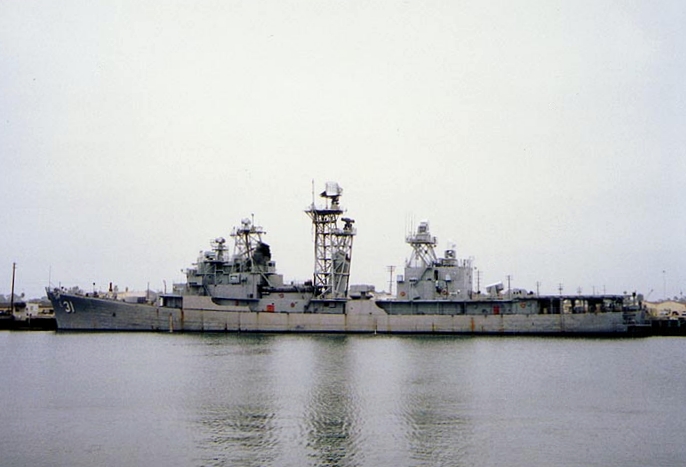
Decatur as the U.S. Navy’s Self Defense Test Ship, 2003.
Despite her name was retired, freed for another ship, she started a new, long career converted in 1989-92 as “E31” as a test ship of a new kind. From 1994 to 2003 she was sent to the Pacific Coast, for trialling new anti-shipping cruise missiles or antiship missiles decoy and ECM tets vessel, testing many new systems later installed on other vessels. As SDTS she was replaced by her sister-ship USS Paul F. Foster (DD-964) and disposed of, as target ship for a Fleet training exercise on 22 July 2004, sunk that day.
 Davis (DD-937)
Davis (DD-937)
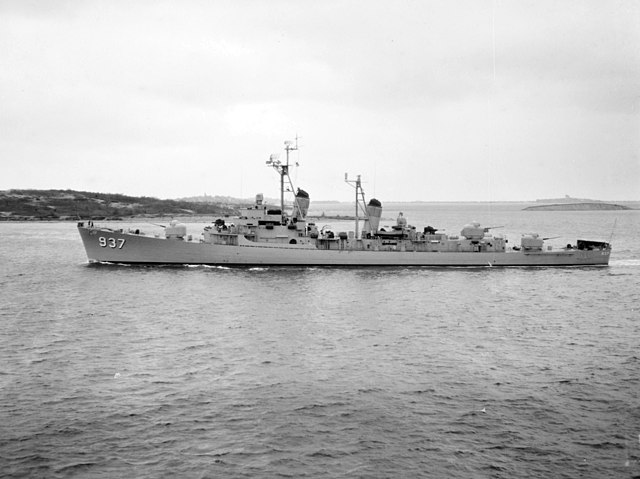
Underway at sea in 1957
DD-937 was completed at Quincy, Massachusetts (Bethlehem Steel Co.) honoring WW2 Commander George Fleming Davis, commissioned on 6 March 1957. After fitting out she made her sea trials from 23 April 1957 off Brenton Reef and joined NS Newport home port in May, making her shakedown in Cuban waters with a stop at Washington Navy Yard for Armed Forces Day celebrations, then NS Norfolk and reached Guantanamo Bay, stopping in Kingston, and Ciudad Trujillo, the in July, started a northern European waters tour via the Azores.
After Ponta Delgada she visited Rotterdam, Copenhagen, Edinburgh, in August and back to Boston for post-shakedown availability. In November she was back to Newport now as flagship, Capt. Harry G. Moore, ComDesRon 12. She started her first Mediterranean tour with the Sixth Fleet from 29 November 1957. Shhe stopped in Cannes, France, in December where she spent Xmas and the new year. She took part in NATO combined ASW warfare and AAW exercises, plane guard for USS Franklin D. Roosevelt, ans the Essex-class Saratoga, Essex and Randolph making many port calls before reaching Gibraltar in April and back to Newport.
After 1958 east coast exercizes she carried midshipmen to northern Europe, taking part in Kiel Week (25-30 June) and visiting Bergen and Rotterdam in July, then back to Boston in August. During a short overhaul she had her aluminum deckhouses strenghtened, and fitted with new expansion joints. From October 1958, calling for Newport, she was underway for Atlantic fleet large ASW drills. She was in Norfolk for her crew to atend the ASW Tactical School and back at sea in December. From 7 January 1959, she took part in Operation Springboard in the Caribbean, also stopping in San Juan, Roosevelt Roads, Puerto Rico, Ciudad Trujillo, San Juan, Saint Thomas (Virgin Islands). In February she visited Washington, D.C. and Mayport in Florida in March, Charleston and Norfolk, followed by a new overhault at Boston from 17 March.
Leaving on 17 June 1959, she took part in Independence Day observances on 3-5 July. After a Cuban waters refresher cruise, she patrol the western and southern coasts of Haiti, stopping at Port au Prince, then Cuban waters in August followed by “special operations.” Next after her annual competitive exercises she took part in Operation Tralex 4-59, testing convoy procedures and amphibious assault operations.
In 1960 she took part in Operation Skyhook measuring cosmic radiations over the Caribbean area, and the usual ASW operations with DesRon 12 soon nicknamed the “Dragon Killers” as they played hide and seek with USS Seadragon. She took part in the North Atlantic ASW Ready Group in March 1960 for intense “hunter-killer” operations, earning seven gunnery “E” awards and joining the Second Fleet for Operation LantFlex 2-60, ending as winner of Battle Efficiency “E”. By August, DesRon 12 departed for the Mediterranean, 6th Fleet, USS David being detached for the Black Sea “on a special assignment”, assorted with a vigorous Soviet Union protest.
DesRon 12 departed for Rota in Spain on 13 February 1961, then back to Boston for her overhaul. In August she took part in an exercise featuring a “simulated Atomic underwater burst” and served with the Fleet Sonar School.
In October 1961, she took part in Task Force 22, 2n Fleet exercizes off the Virginia capes. In Nov-Dec. she served woth TF-140 deployed for Mercury-Atlas 5 space mission. She also assisted the Swedish oil tanker Seven Skies, treating an injured crewman. By February 1962, DesRon 12 was deployed in the Mediterranean (with USS Harlan R. Dickson, Gainard, Hyman, Beatty and Purdy), Sixth Fleet, relieving DesRon 22, USS Davis as flagship. She earned her third consecutive Battle Efficiency “E” and participated in Operation Full Swing, MidLandEx and RegEx 62.
She was back home on 30 August.
In late 1962 she was detached as part of the Quarantine of Cuba, later stopping at Santo Domingo, hosting President Raphael Bonnelly, the back to Newport, joning an ASW task group supporting USS Wasp. By January 1963 and DesRon 12 she took part in Task Group Bravo at the ASW Tactical School, hosting at some point President John F. Kennedy, brought to Costa Rica. It was followed by annual Springboard operations. She also took part in the Mercury-Atlas 9 space flight (Gordon Cooper) recovery. In 1963 she was back to the Task Group Bravo cruise routine.
In August she made a weapons demonstration for students at the Naval War College with USS Bainbridge and in October a “combined demonstration”.
1964 saw a repeat of this patter, with a regular overhaul and assignation of DesRon 12 to CruDesFlot 10, 2ns Fleet Gold Group in October this year. She sailed for the Mediterranean, 6th Fleet on 8 November and was back on 14 March 1965, but was soon at sea for a watch of the Dominican Civil War with USS Myles C. Fox. On 15 July, she conducted a Naval gunfire support practice followed by ASW exercises with TG 83.3. From 3 January 1966 she was prepared for her first deployment in the western Pacific. She transited Panama for San Diego in February, the headed for Hawaii and joined DesDiv 121, Subic Bay on 28 February.
USS Davis’s Vietnam War
On 4 March 1966, USS Davi joined USS Ticonderoga in March 1965 at the southernmost region of South Vietnam. She was detached for shore gunfire on 8-14 March, later alternating Task Group defence duty and these gunnery sweeps. She also served with USS Hancock (1-10 April). She saw the landing on her deck of a Kaman SH-2 Seasprite helicopter for the first time. She was resplenished and maintained at Sasebo, Japan by April 1966, then Subic Bay for tender availability, later eanring the Arleigh Burke Fleet Trophy for 1965. She was in Hong Kong by May, before returning to South Vietnam on northernmost region, shelling targets in the Quảng Ngãi province in support of the 2nd Division ARVN, US Second Advisory Group and Marine at Chu Lai and Da Nang. She left on10 June 1966 for Kaohsiung and returned to the first line, spending 5,000 rounds and even 1,000 of 3”/50 guns. She was back home from 6 July after stopping in Cochin, Aden, Suez, Pireaus, Barcelona and Palma de Mallorca, ending her world tour with a 4th Battle Efficiency “E”.
She took part in LantFlEx 66 and was back for her routine ASW operations in January 1967 and departed for the Mediterranean on 2 May, for the Six-Day War and the USS Liberty incident.
She operated with TG 60.2, 6th Fleet during the Arab-Israeli war and increased Soviet naval presence from the Dardanelles. Davis escorted the USS America and Saratoga, with the cruisers USS Little Rock and Galveston. They were called to assist the attacked technical research ship Liberty by Israeli jets and MTBs 15 miles (24 km) north of Arish.
USS Davis eventually departed Malta on 19 June 1967 for ASW operations in the waters of Crete, and started her summer training, making many port calls and a sonar contact on 24 August with a Soviet submarine, soon joined by USS Fred T. Berry joined Davis. More vessels joined the chase and eventually the Soviet Foxtrot-class F.966 surfaced. She was still in the Mediterranean on 5 September but was soon back to Newport. Captain Leahy later received a Navy Commendation Medal for his role in the Soviet 105 hours sub chase last August 1967. She operated with the Royal Canadian Navy in Operation CanUS SilEx, followed by an overhaul in Boston. Back at sea in February 1968, she took part in Operation Springboard, combininh ASW/AAW exercises and shore bombardment drills. From 30 March she departed for classified “special operations” where she spied on a Soviet-built Komar-class missile boat out of Havana, followed by ASW exercises with TG 83.1, USS Wasp. By July 1968, she was assigned to DesRon 20 as flagship. Transiting Panama in 28 August 1968 for Long Beach Naval Shipyard, she reached Pearl Harbor and Midway, then Subic Bay for her second deployment.
She served with ComDesRon 36 detached for gunfire support at Da Mang and Dong Ha by October 1968 just below the DMZ, supporting the 1st Air Cavalry Division, 3rd Marine Division and acting as Gunline Commander for CTU 70.8.9, shelling positons south of Ben Hao for a joint 3rd Marines Div.-ARVN operation; helping geatly the operation against solid objectives.
However she was fired at by Vietnames guns from Hòn Gió island (Tiger island), which landed 25-30 rounds in ten minutes. The third ended dangerously close astern. In reply she sent 160 rounds and silence the PAVN battery. On 28-29 October she received 22 rounds in her direction from Cape Lay, as well as on 1 November. She was unscathed each time and departed for upkeep in Sasebo.
After visiting Pusan and Hong Kong she reported on station by 16 December, supporting the 1st Marine Division and taking part in Operation Victory Dragon VI, then Operation Valiant Hunt amphibious landing south of Danang.
From January 1969, she departed for rest and recreational visits to Kaohsiung and Cebu, then Subic Bay for upkeep before returning to the gun line. She provided support for the 27th Marine Regiment and ROK’s 2nd Marine Brigade in Quảng Nam province and went on until 15 February before resupplying at Subic and departing for home with DesRon 36, making the voyage with USS DuPont, Power and Hugh Purvis. They visited Sydney and Wellington, the American Samoa and Pearl Harbor and transited Panama in April for Newport retuning to the usual ASW exercize routine.
The seventies
On 17 October 1970 after fitting-out in Boston and InSurv trials she was reassigned to Cruiser-Destroyer Flotilla 10 and DesRon 12. She conducted tests for the Fleet Operational Readiness Accuracy Checks (FORACS) off Cape Cod by December, load ammunition (over 200 projectiles were however rejected for “improper gas check seals”) and was reassigned to DesRon 20 in 1971. She made a srie of drills and weapons test in the Carribean, and joined ComASWForLant with USS Charles P. Cecil and Calcaterra for barrier patrol, relived by her sister USS Mullinnix on 19 February.
She tested her AN/SQS-26 sonar against USS Amberjack in March and made a second surveillance operation for ComASWForLant. In May she was back in European waters, Azores, Netherlands, Hamburg, Copenhagen, before being recalled for “special operations” spying on a new Soviet guided missile destroyer and shadowing her while transiting the English Channel.
Back to Boston she started her long ASW modernization and was back to Newport in October 1971 for a serie of weapons and systems testings with USS Charles F. Adams and Fiske, targeting the GUPPY class USS Clamagore. She later took part in Exercise Snowtime 72-3. By early 1971 she was called for another “special operation” off Cuba and escorted the merchantman Omar Express to Port au Prince in Haiti, then Lincoln Express to the Caicos Passage. She took part in ComPTuEx 72-8 and conducted ASW exercises with USS Skipjack, then LantReadEx 4-72 and a new deployment in the Mediterranean. Bt she was soon prepared for the Pacific again.
Davis’ Last Vietnam deployment
USS Davis and USS Dewey departed Newport on 4 June 1972 for the Philippines under orders of CNO Admiral Elmo Zumwalt assigning them to Yankee Station, assisted by the oiler Waccamaw. They rounded the Cape of Good Hope and arrived at Subic on 6 July 1972 after a 13,000 mile transit, being deployed off Quảng Trị province for gunfire support routine. On 19 July 1972, her AA fire hit by mistake an F-4D Phantom II (7th Tactical Fighter Squadron) which pilot ejected. She was detached on 23 July 1972 to join TU 70.8.2, for supporting ARVN troops near Bồng Sơn and as flagship. On 10 August, one of her gun suffered an in-bore explosion, injuring four. She was repaired at Subic, received a low-pressure modification for 20 rpm instead of 40 and better reliabilit and repair a flooding in compartment 3-44-4-E and damage to the sonar equipment. She was back on the frontline on 25 August.
She relieved USS Eversole as plane guard for USS Midway and then TU 75.9.1 in after a typhoon, to the gunline on 4-11 September and Operation Linebacker, but being so close to the shore she was fired at at several occasion, one round splashing 50 yards (46 m) of her. She was detached on 26 September 1972 for Sasebo via Subic and returned with TU 77.1.1 by October. From 15 October, she started a serie of “PysOps” missions, launching air-filled plastic bags containing “mini-radios” for North Vietnamese to hear non-Communist radio programming.
With ComDesRon 20 aboard as flagship, TU 77.1.1 from 17 October she made the final strike with the light cruiser USS Providence, DDG Hoel and James E. Kyes off Thanh Hóa. Davis later leaft the area, joining USS Joseph Hewes to detect and destroy Vietnamese batteries on Hon Gio, spending the last of 8,315 rounds fired. She stopped in Hong Kong for rest, returned to Subic and embarked Capt. Claiborne S. Bradley (ComDesRon 20) for Singapore with USS Dewey and Joseph Hewes as TU 27.8.4, then heading for home.
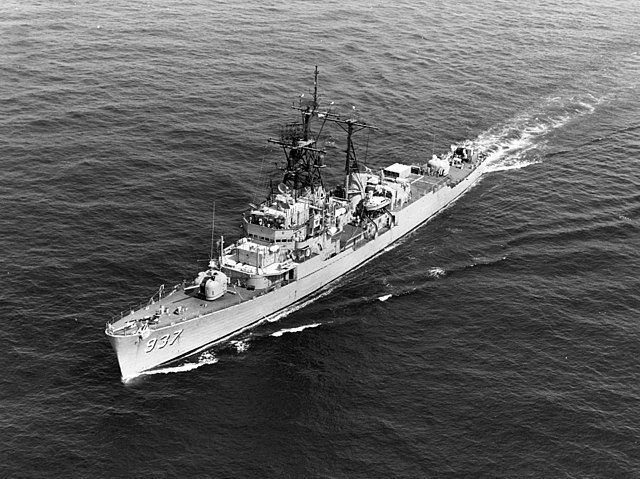
USS Davis in the Indian Ocean, 1979
Post Vietnam Service (1973-82)
They stopped in Bahrain by November 1972 to take later part of exercize Midlink XV, and the crew had a leave at Bandar Abbas, Iran. They stopped in Kenya on their way to Recife, Brazil, then north to Port of Spain, Roosevelt Roads and Newport. Her upkeep done she departed on 26 March 1973 for Charleston and back, the training off Guantanamo. By January 1974 she joined the 6th Fleet at Rota and became flagship, ComDesRon 24 with USS Donald B. Beary and Voge via Gibraltar, making several port called followed by “special operations” in the Gulf of Hammamat and NATO Week exercises. Thereafter she joined the Amphibious Task Force 503 for operation Dark Image in the Adriatic, and exercise Flaming Lance in June, before heading home via Rota.
She took part in ComPTUEx 3-75 in October 1974 and entered the Charleston Naval Shipyard on 19 December 1974 for her regular overhaul. By January 1976, she made a serie of drills and her routine of ASW exervizes, also joined ComDesRon 14, partticipating in UNITAS XVII with the Brazilian, Uruguayan and Argentine navies. She made a first rounding of the Magellan strait to train wit the Chilean, Peruvian, Colombian and Venezuelan navies.
In 1977, she took part in CaribREx 1-77, earning the “Top Gun” award for surface, antiaircraft and naval gunfire support and “Top Hunter” for her ASW work. She would operate under ComDesRon 14, sailing along the coast of W Africa before entering the Mediterranean. She joined the Middle East Force (MidEastFor) operating from Djibouti and later proceeded for Mombasa with Rear Admiral Samuel H. Packer (ComMidEastFor) aboard to return in the Red Sea and Gulf of Aden. She then left for home via Rota in April 1978 and the Azores.
From her new home port of Charleston she sailed with ComDesRon 34 (Naval Reserve Force) aboard touring east coast cities. They entered the great lakes from Montreal and stopped in Detroit, Michigan and Cleveland, Ohio, before heading for Buffalo. Here, Captain Billy B. Traweek was relieved by Captain Daniels (ComDesRon 34) and they ledt the Great Lakes via Toronto and Oswego, then back to Montreal, and Halifax, Davis arriving in Charleston on 17 September for restricted availability, engineering repairs and maintenance. From January 1979, she returned in the Mediterranean, participating in National Week exercises and heading for the Middle East via Port Said and Suez, enterering the Red Sea and Gulf of Aden in March, 6th, fleet and now the 7th Fleet carrier force in April, based in Djibouti. On 15 May 1979, she was ordered back for Berbera, Somalia to hosted the U.S. Ambassador and military attaches from China, Egypt and Italy.
When back home she started her long overhaul from 8 November to 10 December 1980, followed by trials, weapons tests and refresher training in the Carribean and Virgin Islands. Later she joined the Nimitz Battle Group for ComPTUEx 2-81, and back to Charleston, to be redeployed in the Mediterranean on 13 August 1981, 6th Fleet. In September she joined the Nimitz Battle Group, making a halt in Djibouti to join the USS America Battle Group in the Arabian Sea for exercises with the RAN and the ‘Gonzo Regatta’.
In the Persian Gulf she was commended by Rear Admiral Charles E. Gurney, III (MidEastFor). Back ion the Med, she carried out exercises off the coast of Libya and sailed for home with ComDesRon 20 embarked. From 25 January 1982 she resumed her training routing, taking part in Ocean Venture 82, landing at Vieques, and later United Effort/Northern Wedding-82 with NATO, the largest peacetime exercise, before joining America Battle Group off the Virginia capes training across and to the English Channel, stopping at Southampton, then Brest, France, and recalled for the eastern Mediterranean and the crisis in Lebanon. She also took part in NATO’s Display Determination 82.
Back in October 1982 decommissioning process started with ammunition offload at Charleston, and moved to the Inactive Ships Maintenance Facility, formal decommissioned on 20 December 1982, stricken on 27 July 1990, sold for scrap to Fore River Shipyard in December 1992, resold to N. R. Acquisition Inc. NYC, same, and Wilmington Resources, North Carolina.
 Jonas Ingram (DD-938)
Jonas Ingram (DD-938)
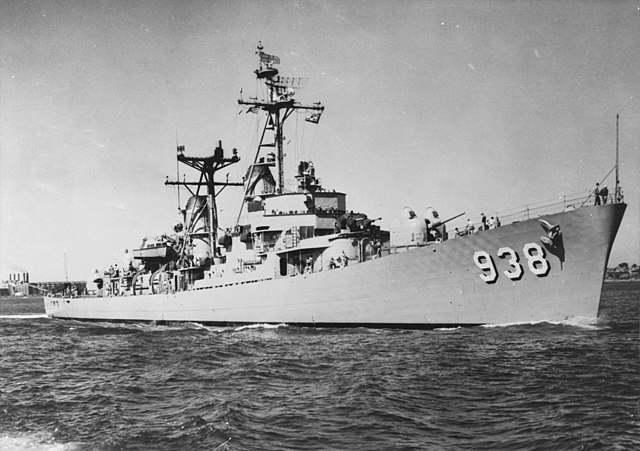
After her shakedown cruise in the Caribbean and down South American’s west shores, USS Jonas Ingram was back in Boston and from 26 February 1958 patroled the West Indies, based to Newport in September and making her first Mediterranean tour of duty (MED TOD) with the 6th Fleet, taking part in NATO exercises.
She was reasigned to Mayport NS in Florida and tasked of recovery ship duties for Project Mercury on 25 June. She became flagship, RADM E. C. Stephen at the head of South Atlantic Forces, starting a training cruise in August and training with the French and South African navies, back in November.
She provided an air-sea rescue cover for President Eisenhower’s flights to the Paris Summit Conference (May 1960) and another one for Project Mercury before a TOD off the African coast to support the UN in Congo. On 18 October she took part in NATO exercises in Northern European waters. The next years she alternated between the Mediterranean deployments and Mayport-based cruisers. In September 1964 she took part in Malta’s Independence ceremonies. Back home she was a recovery ship for the Gemini program. By Feb. she made a combined North Atlantic ASW exercise, then Operation “Springboard” in the Caribbean, then cruised Middle Eastern waters, stopping at Djibouti, Berbera, Aden, Karachi, and Beirut.
After taking part of the recovery fleet for Gemini 6, Atlantic and Caribbean deplyments in 1966, she returned with the 6th Fleet and on September with USS Stribling went to Port Said in Egypt.
The last months she took part Exercise “Lantflex 66-2.”, until late December. She started for another MED TOD on 17 July 1967 via Gibraltar.
However later this year she was taken in hands for a decommissioned and ASW modernization at Philadelphia Naval Shipyard. She recommissioned in Philadelphia in 1970 and returned to Mayport, later ast sea for a rescue of the freighter Saudi’s crew off Somalia, saving 58 and earning a Meritous Unit Citation. On 4 October 1976 she made anotehr rescue for a Finnish motor craft in the Baltic.
The next part of her career has not been published to my knowledge. She was decommissioned on 03/04/1983 and stricken 06/15/1983, but not scrapped. She was retained for tests. When performing first live fire test of the Mark 48 ADCAP torpedo on 23 July 1988 (“Disposed of in support of Fleet training exercise”), she sank, creating an artificial reef.
 Manley (DD-940)
Manley (DD-940)
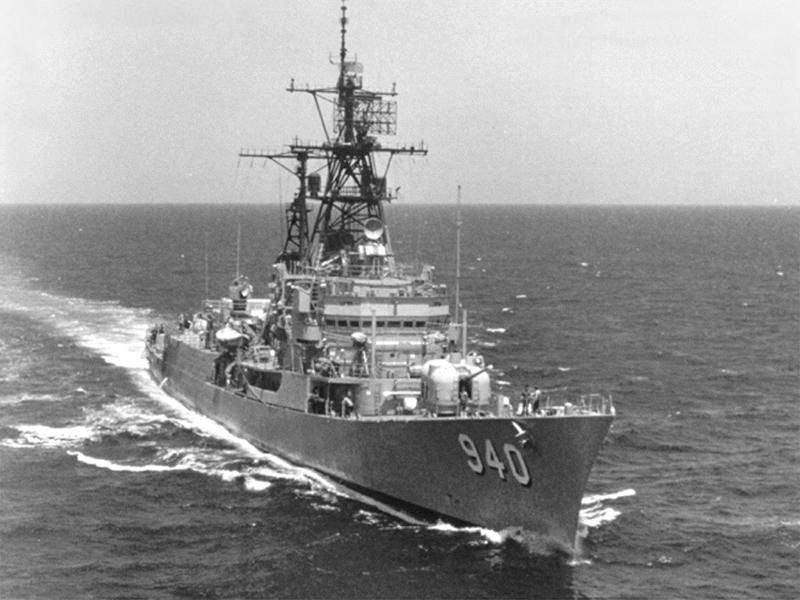
USS Manley in 1970
USS Manley after completion, trials, post trials fixes, departed Newport in Rhode Island, on 11 April for her shakedown cruise in the Caribbean. On 7 June she stopped in San Juan, Puerto Rico and went on her goodwill tour to Lisbon, Amsterdam, Kiel, and Copenhagen and back to Boston for post-shakedown alterations. On 22 August 1957 she escorted the attack carrier strike force during NATO Exercise “Strike Back. off Scotland, and later the coast of Norway north of the Arctic Circle. Back to Norfolk in October 1957 she became flagship, DesRon 4 for DesDiv 41.
On 4 December 1957, she made he first MED TOD with the 6th Fleet with USS Gearing, McCard, Vogelsang. ASW mock attacks was stopped on 11 December by heavy in the Azores. On 12 December, the she took a rogue wave by her side, killing two and injuring several sailors, having her galley mushed, her radio and radar rooms flooded. Battling 80 knots winds and rain squalls she limped back to Lisbon for repairs, and headed for Gibraltar, Royal Dockyard for repairs until 4 January 1958 before leaving for Norfolk via Bermuda, Philadelphia yard for final repairs. She was back later as flagship, DesRon 4.
Mediterranean and Atlantic Service
On 6 June 1958, she sailed with the Atlantic Fleet and toured Europe (Kiel, Copenhagen, Antwerp) with USS Lake Champlain (CV-39). Next she sailed with USS Intrepid, for 2nd Fleet maneuvers off Puerto Rico. Next she was assigned to USS Franklin D. Roosevelt on the eastern seaboard. In 1959 she was seen off Guantanamo Bay in ASW practice, and moved to Homeport Charleston after upkeep and maintenance. Back in the Mediterranean she took part in joined exercizes, British “Long Haul,” and French “Boomerang.” After an overhaul in Charleston she trained off Culebra Island, Caribbean (live fire). On 27 July she was in station 5, Atlantic Missile Range for the Mercury program. Next she was in an experimental ASW exercize off Cardiff, Wales. She also trained Majorca ad joined USS Forrestal (CVA-59) task force off Beirut for 6th fleet manoeuvers.
She covered USS Franklin D. Roosevelt south of Hispaniola and by 1962, was a recovery ship for Project Mercury, North Atlantic. On 28 September she made a refresher training, rescuing a downed helicopter pilot and stayed in Cuban waters for the Cuban Missile Crisis. Back home she recued the crew of the yacht Avian in the Atlantic.
Late January 1963, she took part in “Springboard ’63” and screened USS Essex for joint Canadian-US ASW exercises from Halifax. Later that year she departed for her MED TOD eve becoming the provisional 6th fleet flagship during at Tunis. In December she went with the Middle East Force, her XO Lt. Cdr Joseph E. Murray, Jr. negotiating with armed rebels in Zanzibar and departing with 91 American citizens held hostages. After upkeep in Charleston she made another 1965 MED TOD, representing the US at CENTO in Turkey. After the collision of Kaskaskia and SS World Bond near St. Helena she rescued 23 passengers and crew while her teams combating fires and flooding saved the ship.
Vietnam Tours of Duty 1966-68
On 9 August she was in recovery station for Gemini V. She was prepared for upcoming operations in Southeast Asia and departed Charleston on 5 October 1966 for DesRon 20 based in Gitmo, heading for Vietnam. Underay she assisted the Greek merchant ship Marcetta. On 21 November she replaced USS Hull off Da Nang, as part of TU 70.8.9 for gunfire support with the 7th Fleet. She had a powder case igniting in her forward gun mount and the explosion was followed by a control avoiding more damage, no death, but casualties evacuated by helicopter. In Da Nang she disembark her visiting observer, Senator Henry M. Jackson. Repaired in Subic Bay repairs, she assisted USS Enterprise and USS Bainbridge in the Gulf of Tonkin, then joined TG 77.4 with USS Bennington, being awarded the Navy Unit Commendation for sustained service, before heading back home in May 1967. She was back in the Western Pacific by September, and stayed there more than 8 month, back to her homeport in June 1968.
Modernization and Late service 1971-83
She was decommissioned on 31 January 1970 for her ASW modernization at Philadelphia. When recommissioned she was assigned to CruDesFlot 4 based in Norfolk. After a shakedown cruise in the sprin og 1972, she joined DesRon 12 for a new local homeport, Athens in Greece, taking effect on 1 September 1972. For 30 months she was called for many exercises and as an observer on the October 1973 Arab-Israeli war and Cyprus crisis of 1974. After upkeep back home in Philadelphia by December 1976, she moved to Mayport in Florida and by March 1977, joined the 2th fleet and later 6th Fleet (November 1977 – July 1978) ending with a goodwill tour and exercizes in Northern Europe. On 8 April 1979 in Mayport her fwd boiler room erupted in flames while udner repair, and she had 12 men were burned, one later dying. After repairs she was underway in October 1979 for an exercize beyond the Arctic Circle.
Later she was back in the Caribbean Sea, touting islands and moved to Boston for a refit and sea trials in 1980-81, returned to Newport, and trained in Narragansett followed by exercises in Guantanamo Bay. Until 3 May, she conducted more ASW drills of Puerto Rico and by June 1982, made her last cruise, a “farewell goodwill tour” in the Mediterranean. She assisted evacuations from Beirut during a new crisis and via Suez and the Indian Ocean stopped in Karachi, Pakistan, followed by MidEastFor exercises. She was back in her last homeport in december, and decommissioning, stricken on 4 March 1983. After the two companies in charge of her demolition were bankrupt she ended at Wilmington Resources in North Carolina.
 Du Pont (DD-941)
Du Pont (DD-941)
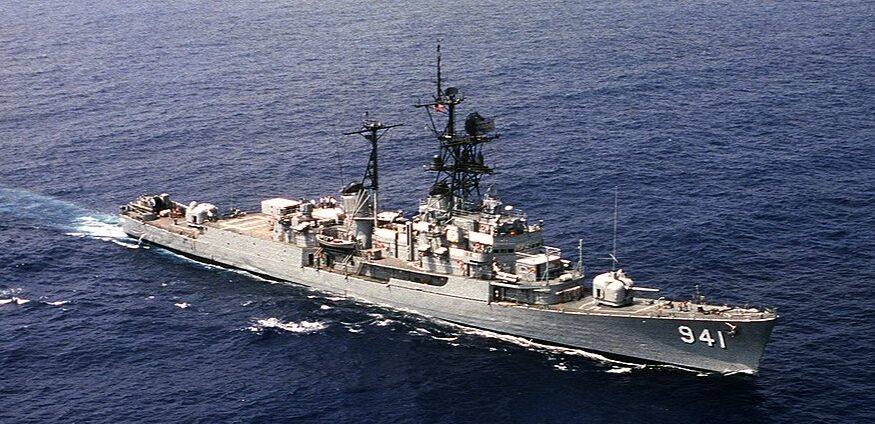
USS Du pont off Lebanon in 1982
Until 31 July 1958 after her sea trials, short shakedown in the Carribean and fixes, USS DuPont served as a midshipman schoolship, undertaling ASW exercises in the Atlantic and a stop in New York. On 2 September she started her first 6th Fleet MED TOD, back in Norfolk on 12 March 1959, followed by Operation “Inland Seas”, a sortie into the Great Lakes through Saint Lawrence and escorting HMY Britannia with Queen Elizabeth II aboard for ceremonies on 26 June. By August-September 1959 she visited Southampton and acted as plane guard for President Dwight D. Eisenhower flight to Paris. On 28 January 1960 she started her 2nd MED TOD, back on 31 August for an overhaul.
After exercises and drills in 1961-62 she took part in the quarantine, part of the Cuban Missile Crisis, also acting as command ship when looking for the submarine USS Thresher lost off Boston on 10 April. She piled up three excellency “E” awards in Engineering, followed by a 5th MED TOD until mid-1964. Her 6th deployment was interrupted by a role in the Gemini 5 program recovery. She recovered not the crew, but a booster section carried back to Norfolk. She also acted during the Dominican Republic crisis, earning a golden “E” and resumed operations with the 6th Fleet in 1966, and a Caribbean cruise, plus a 7th Engineering ‘E’, making USS DuPont the most decorated destroyer in peacetime so far.
DuPont’s Vietnam War
Her first deployment with the 7th fleet started in August 1967, on the “gun line” direct support to the Marines on the DMZ. Shore batteries fired at her several times and she always replied accurately, silencing them, day and night. On 28 August USS Robison between Du Pont and the beach was hit, maneuvered to seaward, replaced by DuPont which was soon framed by twenty 130 mm (5 in) rounds. One of her main 5-in/52 gun mount was hit, shrapnel going through and in the after deckhouse, killing FN Frank L. Ballant, wounding 8.
She stayed there for two more weeks and headed to resupply and repairs at Subic Bay, then resume action at the gun line on 10 October. On 10 November she was back for a last deployment there, being awarded later for continuous 65 days in combat, furing a total of 20,000 rounds. Eight men received purple harts. Back to Norfolk in January 1968, she was in drydock repairs before taking part in the Apollo recovery force. It was follwed by a Caribbean refresher and training midshipman while her engineering department won its 9th excellence award.
Her second Vietnam TOD started on 10 October 1968 for 36 days on the gun line, in close support for the SEAL and ARVN operating in the Mekong Delta. She also fired on an Island in the Gulf of Siam and fire support for the Ist Corps in Da Nang, then an amphibious landing in December. In 1969 after a supply run to Subic, she was back to support the 1st Marine Division at Da Nang and massive amphibious landing in the south, also supporting Mekong River Delta operations. She spent 30,000 rounds, claimed 730 military structures, 131 small craft when back to Norfolk, and entering the Boston Naval Shipyard to be decommissioned on 23 May 1969 and converted to an ASW vessel.
Later service 1972-83
After recommission on 9 May 1970, she headed for Norfolk and departed for ASW workout and drills from April 1971, also departing for the Caribbean and Mediterranean. In 1972, she won the Marjorie Sterrett Battleship Fund Award for her Atlantic Fleet servce and in 1979, moved to to the Bethlehem Steel Works in Hoboken, for yet another major refit. In 1980, she was attached to Comdesron 2 (Cmdr. Harlan K. Ullman) and returne to Norfolk and then left for Cuban waters and two weeks of refresher training. She received 3 Battle “E’s” in complement of her 9 engineering “E”.
In 1981 she departed for her last MED TOD and Persian Gulf operations, notably “Mail Call flight” in the Red Sea as part of the Nimitz battle group. She stayed in patrol until after the American hostages held in Iran escaped. She watched as the fleet was approached and spied daily by Iranian P-3 Orions. In 1982 she assisted Israel, fighting PLO operations in Lebanon and remained off Beirut for 100 days, providing on demand fire support. Eventually after this last gasp of the “last gunflighter”, she went for home and decommission on 4 March 1983, sold on 11 December 1992 to the Fore River Shipyard.
 Bigelow (DD-942)
Bigelow (DD-942)
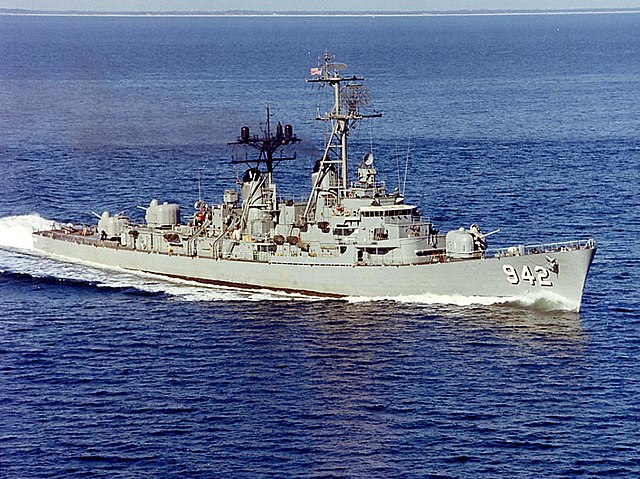
USS Bigelow (DD-942) named after Elmer Charles Bigelow (1920-1945) KiA while extinguishing a magazine fire in USS Fletcher at Corregidor in February 1945, MoH recipient, was completed at Bath Iron Works in 8 November 1957, and soon part of the Combined Task Group CTG 136.1.1 blockading Cuba during the Cuban Missile Crisis and later awared the Armed Forces Expeditionary Medal for her action during the quarantine. After a yearly routine of Mediterranean TOD with the 6th fleet, back home, she also acted as a NASA recovery ship during both the Mercury and Gemini III programs.
In 1966 she was sent in Vietnam with the 7th fleet, alternating between direct support on the fire line and screening the carriers. On 20 April 1967 she suffered a gun mount explosion, injuring six and killing one crew. Sge also became a test platform for the new Phalanx CIWS hyperfast minigun in 1977, installed aft of the aft radar gun director. She was not modrnized, and thus, decommissioned earlier than others, on 5 November 1982. Sold for BU at Fore River Shipyard (bankrupt), then N. R. Acquisition Inc. but ended as target ship, stricken 1 June 1990 and sunk on 2 April 2003.
 Blandy (DD-943)
Blandy (DD-943)
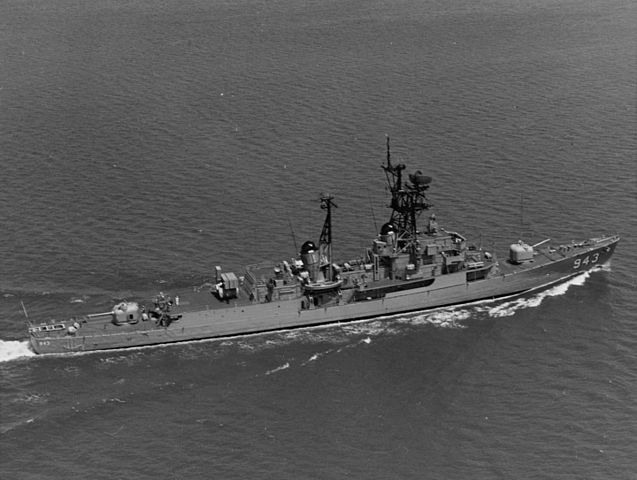
USS Blandy after her ASW modernization underway in the 1970s
USS Blandy was completed at Bethlehem Steel Corp. Quincy on 26 November 1957. After the usual trials and shakedown in 1958, she carried the US Unknown Soldier (European theater) from Naples to Virginia Capes, to meet Boston (CAG-1) doing the same from the Pacific and Canberra (CAG-2) for the Korean war. The latter caskets were transfered to Blandy which headed for Washington, D.C. to be transferred in the Capitol Rotunda and Tomb of the Unknowns in Arlington National Cemetery.
In 1961, she won the Marjorie Sterrett Battleship Fund Award, Atlantic Fleet for excellence and on 30 October 1962 while on ASW patrol she tracked the Soviet submarine B-130 too close to the US vessels and trying to force the Qyanratine at Cuba. Blandy dropped warning charges and tried to force her to the surface, which after 7h of relentless chase, Captain Nikolai Shumkov did, due to tje lack of oxygen.
Bandy did not made a tour of duty in Vietnam unlike most of her sisters. She spent most of her service days bnetween the Atlantic and Mediterranean, 2nd and 6th fleets.
In 1968 she was awarded the Arleigh Burke fleet trophy award for her Atlantic Fleet servoce, complemented the Sterrettt award. In 1972 she underwent her ASW Modernization, SCB 251 program. She was eventually decommissioned on 5 November 1982, stricken on 27 July 1990, sold for scrap but resold, and ended at Wilmington Resources, Wilmington (North Carolina) in 1996.
 Mullinnix (DD-944)
Mullinnix (DD-944)
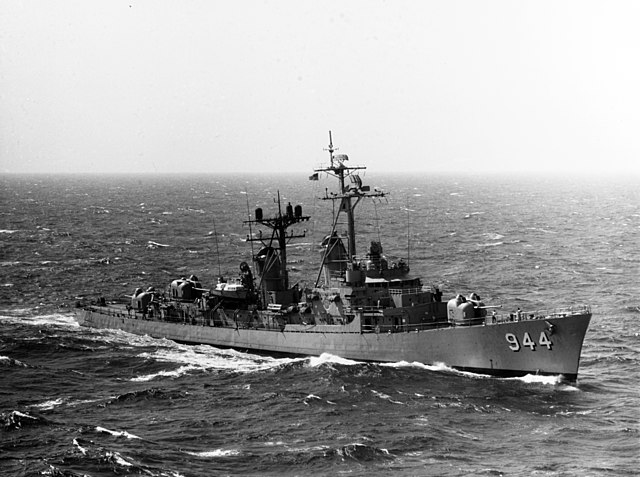
USS Mullinix in the Mediterranean, 1970
USS Mullinnix (DD-944) (named Admiral Henry M. Mullinnix USN, 1892–1943, KiA in WW2 on USS Liscome Bay, 24 November 1943) was completed at the Bethlehem Steel Corporation’s Fore River Shipyard in February 1958 and commissioned on 7 March 1958. After her sea trials, shakedown and fixes, she started her career of early routine on the east coast, cruising between Halifax and the Carribean, Atlantic exercizes, and patrolling Cuban water during the Missile Crisis of 1962. This was alternated with recovery ship task during the Gemini program (March 1966). She was soon sent to the Vietnam theater, acting as plane guard for the aircraft carriers of Yankee Station, Tonkin Gulf. She also took part in Operation Sea Dragon patrolling North Vietnamese waters, and perform search and rescue missions or support naval gunfire missions.
Back from Vietnam, after her usual peactime service in the Atlantic, and European, MED TOD, she was taken in hands for modernization in 1971, SCB 251 ASW conversion program.
She was deployed for an additional decade of service in the Atlantic without notable events, eventually decommissioned on 11 August 1983, stricken on 26 July 1990 and sunk as a target on 22 August 1992.
 Hull (DD-945)
Hull (DD-945)
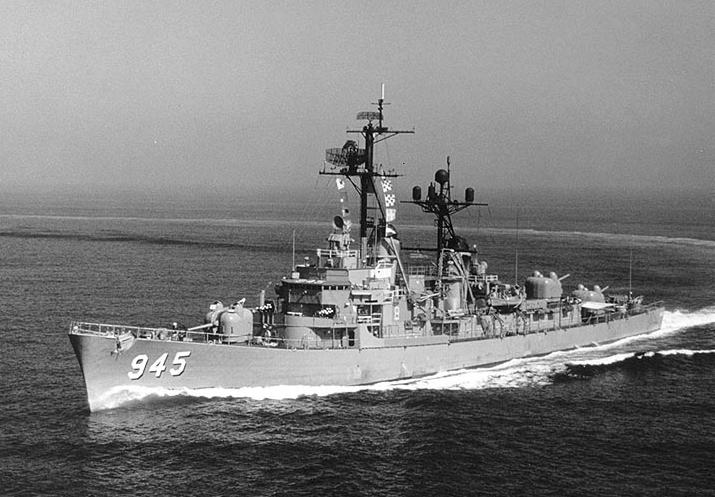
USS Hull was built at Bath Iron Works, and commissioned on 3 July 1958. After her trials and shakedown cruise in the Carribean, she was assigned to the Pacific fleet and transited the Panama canal.
Between April and August 1959 she made fifteen deployments with the 7th Fleet, Western Pacific, and 1960, 1961–1962, 1963–1964.
In October-November 1962 she escorted the Pacific amphibious forces to Panama, made ready to land in Cuba of needed as an option during the Cuban Missile Crisis. In 1965 USS Hull was back in the Pacific and took part in the Vietnam War, making six deployments. She was part of the “gun line”, firing more than 80,000 rounds in various occasions, supporting Marines and later ARVN forces ashore. She also recued several pilots and alternated as plane guard fo Yankee Station carriers in the Tonkin Gulf She also took part in Operation Sea Dragon operations.
Her 11th WestPac cruise was done in 1973, when direct US involvement ended. Back home she was installed the new USN 8 inch/55 MCLW gun for weapons trials, off San Clemente Island (California), on September 17, 1975. Indeed as she had a major overhaul in 1974–75 like her sisters (ASW conversion) she also received at this occasion the Major Caliber Lightweight Gun (“MCLWG”) in place of her forward 5-in turret. The project was a direct result of Vietnam operation when it was realized that heavy gunfire support for amphibious operations could not be sustain by the reducing fleet of WW2 heavy cruisers veterans. The USN planned a big gun fir for destroyer-size. The prototype gun was already tested ashore in the early 1970s and installed on USS Hull for seagoing trials. It was hoped an adoption on the new Spruance class.
The tests went on until April 1976, reportedly successful and she kept it in her 1976-77 and 1978 deployments to the Western Pacific, testing it time and again. However, the MCLWG project was terminated in 1978 due to budget cut, and it was removed from USS Hull during her 1979-80 overhaul. By February–September 1981 she was in the pacific, and again in 1982 and 1982, September, for her final WestPac all the way north to Alaska. There, she rescued five deriving Vietnamese refugees in October. She made her ultimate cruise by sailing to the Indian Ocean, Arabian Sea, assigned to the USS Enteprise battle group for Middle East Operations, notably the crisis in Lebanon.
Back home in April 1983, she was inactivated, decommissioned on 11 July 1983, stricken on 15 October 1983, but not scrapped. Instead she was expended as tactical test target, sunk on 7 April 1998.
 Edson (DD-946)
Edson (DD-946)
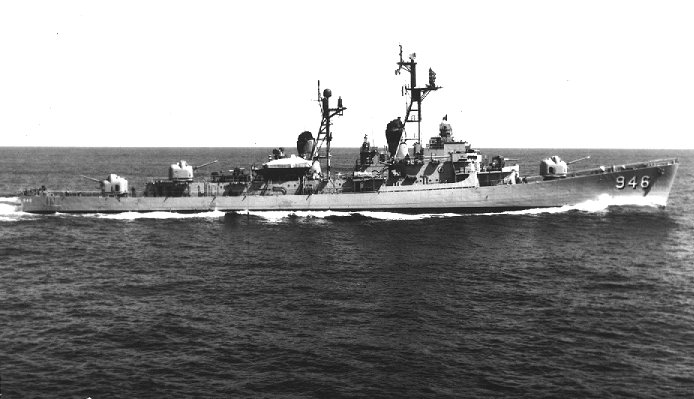
USS Edson after commissioning, in sea trials.
USS Edson was named after Major General Merritt “Red Mike” Edson, USMC (1897–1955) awarded the MoH for his action in the First Marine Raider Battalion on Guadalcanal, also awarded the Navy Cross and Silver Star. She was commissioned at Bath Iron Works Corp. on 7 November 1958. After sea trials, she made her shakedown cruise in Caribbean ports and down to Peru. Jer home port became Long Beach in California on 2 March 1959. She was deployed on the Far East, Taiwan Straits and took part in amphibious operations off Okinawa plus exercises off Japan. After an overhaul until Octobe she trained off San Diego.
Soon she resumed her yearly WESTPAC deployments, from June 1961 with DESDIV 231. She served in 1962 with USS Ranger and Ticonderoga, alsways on patrol duties off Taiwan. From March 1964 she served alongside the Taiwan Patrol Force CTF 72. She made Gunfire Support Training in the Philippines and took part in NATO LICTAS joint SEATO operation off the Philippines. She was soon sent in the Gulf of Tonkin for “special operations” awarded the Navy Unit Commendation for her actions on 2–5 August 1964. In 1967, she was hit by a North Vietnamese shore battery while in gunfire support.
She also acted as plane guard in Yankee Station and took part in Sea Dragon. On 17 June 1968 she apparently took friendly fire (courtesy of US Air Force).
Back from her Vietnam service she resumed her peacetime routine with the 7th fleet.
Nothing notable (she was not modernized) but on 12 December 1974 she suffered a fire in her after fireroom while guarding USS Coral Sea. The oil from a ruptured lube oil gauge line was to blame. The was no casualties. In January 1975 she made another WESTPAC and took part in Operation Eagle Pull, the evacuation of Phnom Penh in Cambodia, then Operation Frequent Wind, the evacuation of Saigon (eanring two Unit Commendations).
After another decade (1976-86) of service in the Pacific she was eventually placed in reserve but only decommissioned on 15 December 1988, quite a feat for an unmodified Forrest Sherman. She was towed to the Philadelphia Inactive Ships Maintenance Facility for storage, but as the last all-gun destroyer she was saved and converted as a museum ship, berthed as the Intrepid Sea-Air-Space Museum, New York City from 30 June 1989 to 14 June 2004, declared a National Historic Landmark in 1990.
However funding was lacking. On 2004 she was towed to the Brooklyn Navy Yard, repaired and back to the Philadelphia Inactive Ships Maintenance Facility. She was to be acquired either by the Saginaw Valley Naval Ship Museum at Bay City or the Wisconsin Naval Ship Association at Sheboygan and the Bay City proposal won, and as the ship was seaworthy on 17 July 2012 she arrived at museum site on 7 August 2012 and moved to her permanent mooring site in May 2013 at Bangor Township in Michigan where she can be visited today.
 Somers (DD-947)
Somers (DD-947)
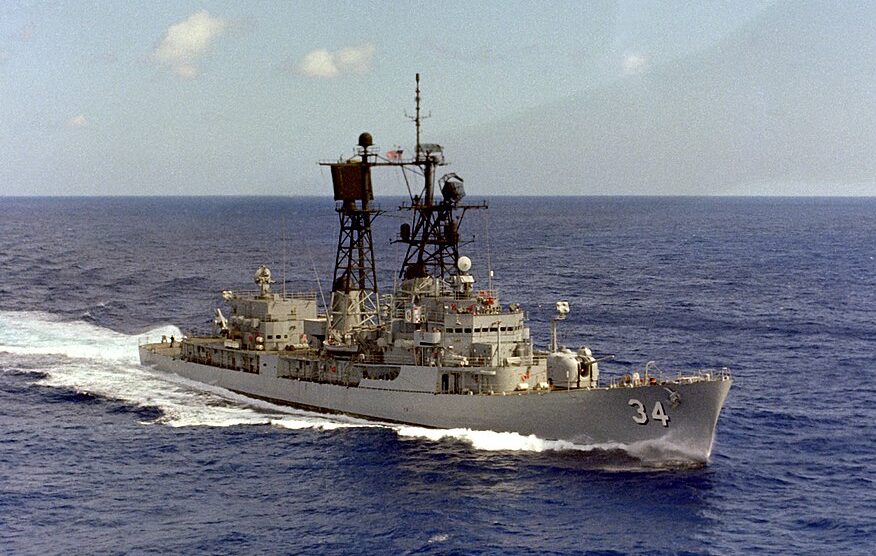
USS Somers as DDG-34 in the 1980s
Sixth ship of the nae in the USN (going back to the very early days of the service) USS Somers was built at Bath Iron Works Corp in Maine, commissioned on 3 April 1959 with Edward J. Cummings, Jr., in command as first captain.
She departed, her trials barely completed, on 1 June 1959 from Boston to her new provisional homeport Newport in Rhode Island and made her first cruise, to Argentia in Newfoundland and from there, northern Europe (Copenhagen, Stockholm, Portsmouth, Kiel), present at the “Kiel Week”. Back home she transited via Bermuda and arrived in Cuban waters before proceeding via the Panama Canal on 19 July to San Diego, completed her shakedown training for six weeks and made her final acceptance trials on 17 September followed by an overhaul until 8 November.
The next six years, from San Diego she made near-yearly deployments with the 7th Fleet, western Pacific. She only stayed on the west coast in 1962 and 1964. That same year however she arrived in the Tonkin Gulf for plane guard dueites assisting USS Coral Sea, Hancock, and Ranger already attacking North Vietnam. On 30 July 1965 based at Yokosuka she went home for upkeep, and by April 1966 had her DDG conversion in San Francisco Shipyard. From 16 May 1968 she headed for Long Beach, and in 1969 trained from Mexico to Washington.
On 18 November 1969, was back in Vietnam, based in Subic Bay. She acted as SAM cover for the carries in the Gulf of Tonkin, and plane guard for Hancock. She later took part in SEATO “Sea Rover.” She was assigned later USS Constellation. Back to Long Beach on 8 May 1970 she took part in PACMIDTRARON 70 cruise. She made another Vietnam deployment (December 1970 – 4 May 1971) as plane guard alternated with naval gunfire and in between visited Keelung, Hong Kong, Singapore, Penang, plus her usual upkeep stays at Subic Bay.
On 9 August she was overhauled in Long Beach Shipyard until 3 December and refresher until March 1972 then back to 7th Fleet, Gulf of Tonkin until October. She was also at south Talos station and PIRAZ station. She was back in Long Beach on 9 November 1972. On 9 October 1973 she was back in the western Pacific from Pearl Harbor and Subic Bay. Thuis last Vietnam TOD ended by mid-May 1974. By November 1978 she made her 10th WestPac. By early 1981 she participated in READIEX 5-81 and FLEETEX 1-81, then Battle Group Delta (USS CONSTELLATION, CV-64). Her 11th WESTPac was mostly spent in the Indian Ocean. She stopped in Diego Garcia, Bunbury, Maldives and Singapore. After READIEX 2-82 and was decommissioned on November 19, 1982. She entered the Inactivation Ship Facility at Pearl Harbor until 1988. She was an experimental hull at Port Hueneme, California. Later she was towed at sea and sunk by USAF B-52 Stratofortresses’s AGM-142 missiles 30 nm northwest of Kauai, Hawaii (Pacific 1998 exercise).
 Morton (DD-948)
Morton (DD-948)
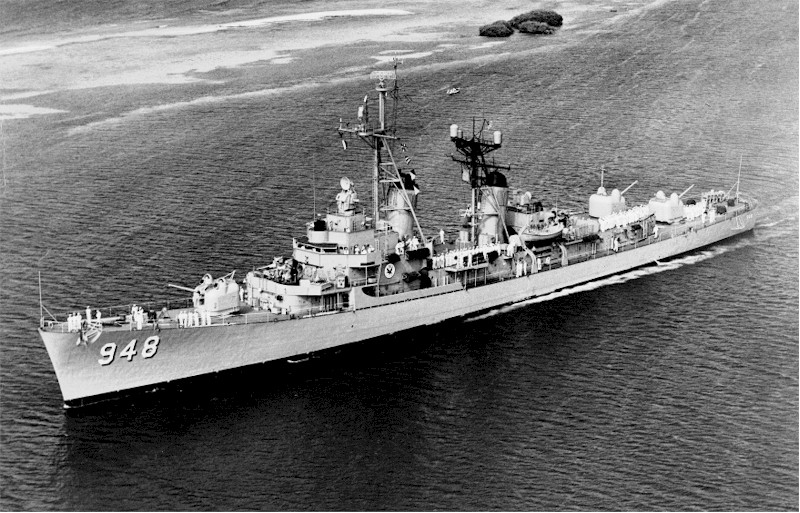
USS Morton in October 1959 off Aruba, Carribean.
USS Morton was built at Ingalls, commissioned on 26 May 1959, named after Sub captain Dudley “Mush” Morton of USS Wahoo. After her training cruise in the Caribbean she was attached to NS San Diego, from 20 October 1959. Her first WestPac followed in January 1960 and joint Operation Blue Star with the Marine and Air Force by March 1960. She visited Bombay. Her second deployment saw her deployed in the Formosa Patrol, and relief Operation Handclasp for Taiwan. Her thord WestPac started in November 1962, again the Formosa Patrol and training off Japan. Her 4th deployment was in the South China Sea, off South Vietnam.
On 11 September 1964 (soon after the Gulf of Tonkin Incident) an intercept team SIGAD USN-467P was formed aboard USS Morton for a DESOTO patrol (Operation 34A), screening aircraft carriers and bacl home on 6 February 1965. She was back in Vietnam in April 1966 for shore gunnery missions for 4 months and Sea Dragon operations off North Vietnam from May 1967. She also covered the 12th Marine Regiment near the DMZ. She was back on the gun line on October 1968. Back home she was overhauled at Long Beach Naval Shipyard from September 1969 to 15 August 1970, for ASW conversion.
USS Morton stayed on the west coast for months of training. She was back for a WestPac from 9 September 1971, two gun-line tours and by March 1972 was in Australia. She was back home and resumed Vietnam Ops in October, making two more gunline tours and taking part in the Linebacker raid by December. After the ceasefire of 28 January 1973 she went home. Her next WestPac provided screen and escort for the carrier task forces, cut by intensive ASW exercises. However in 1974 she underwent serious boiler issues while in the Philippines and was overhauled in Pearl Harbor in 1975-76.
She started another deployment from February 1977 and sailed to the Indian Ocean patrolling off Iran, depliyed again on 11 September 1978 between Japan, South Korea and Taiwan. From 3 May 1980, she was overhauled and back to normal service in the summer of 1981, making her last deployment by February 1982. She also rescued Vietnamese refugees, later receiving the Humanitarian Service Medal. She was eventually decommissioned at Pearl Harbor on 22 November 1982. Sold to Southwest Recycling, Inc. (Calif.) for scrapping and recycling in 1992.
 Parsons (DD-949)
Parsons (DD-949)

USS Parsons, named after a rear admiral which took part in the Manhattan project, was built at Ingalls and commissioned 29 October 1959 after a training cruise in the Caribbean. Based in NS San Diego she made her first western Pacific deployment in February 1960. By October 1961 she was overhaul at Long Beach for communications and ASW upgrades, then training with the 1st Fleet until November 1962 and a 2nd WestPac, back in July 1963. Under command of Cdr. Jack Jester she made several AAW and ASW operations off California and escorted USS Midway (CVA-41) and Hancock (CVA-19) to the Western Pacific, then back to San Diego.
She was selected for conversion as DDG (Decatur class) with John Paul Jones and Somers as DDG-33, starting in 15 March and ending on 3 November 1967, the fastest conversion of all of these vessels. She joined the Cruiser-Destroyer Force of the Pacific Fleet and became flagship of DesRon 31, with the 7th Fleet off Vietnam, Yankee Station plane guard and on-station training, ASW training coordinator, ComDesRon 31. She also visited Kaohsiung, Yokosuka, Hong Kong, Singapore and Sasebo. She also served with DesRon 15 from Yokosuka. From December 1971 to December 1972 she acrtively take part in late Vietnam War operations between naval gunfire support (I and IV Corps areas) and Marines close to DMZ, SAR operations North South stations, northern Tonkin Gulf. And finally carrier escort/plane guard on Yankee Station. She left Vietnam definively on 19 December 1974 but returned to save Vietnamese refugees in October 1980 off Saigon.
In the 1980s she performed a great range of AAW, ASW and SUW plus Naval Gunfire Support (NFGS) missioned and some Electronic Warfare until decommission on 19 November 1982, stricken on 1 December 1984, sunk as target on 25 April 1989.
 Richard S. Edwards (DD-950)
Richard S. Edwards (DD-950)
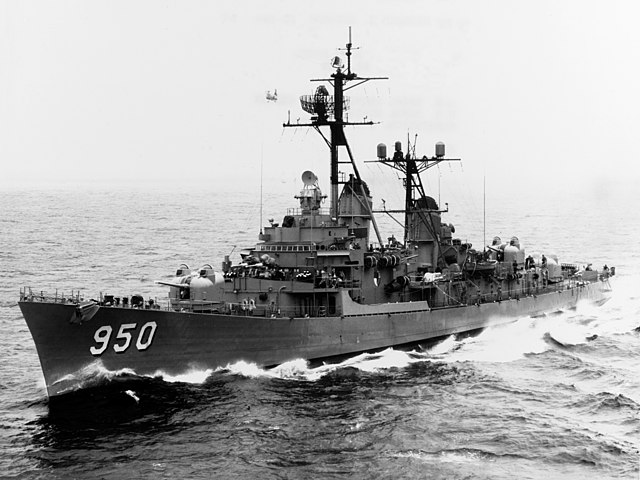
USS Richard S. Edwards underway in the Pacific, 1962
Richard S. Edwards, named after Admiral Richard Stanislaus Edwards USN (1885–1956) was completed in January 1959 at Puget Sound Bridge and Dredging Company and commissioned on 5 February. She made her shakedown cruise to Mazatlan, Mexico, and transited the Panama Canal, sailing souht to Valparaiso in Chile. However her newly installed boilers were leaking so much she had to limp back to Seattle with just one shaft running. On 11 August she was refuelling from USS Bennington, when the latter lost control and veered to the left and sideswiped Edwards, causing extensive damage on her port side, but there were no injuries. That was notably due to the anticipation on Boatswains Mate Lionel Sepulveda which ordered all personal to clear the port side. She ended oin long repairs at the Naval Shipyard of Long Beach before proceeding to NS San Diego.
Her first WestPac deployment via Pearl Harbor and she rescued underway the crew from a tug, in the midst of a typhoon for 21 days, with Air Force Cadets onboard as she listed to 47° and shook violently. Later she operated with the 7th Fleet and took part in the Taiwan Patrol Force. Her next WestPac started in February 1961, fast carrier group, South China Sea. Her 3rd started on 13 November 1962, fast carrier operations and 4th from August 1964, this time engaging North Vietnamese torpedo boats in the Tonkin Gulf (18 September).
Her 5th deployment, this time as part of her Vietnam TOD, started on 1 March 1966, until 26 August, providing naval gunfire and plane guard duties in the Tonkin Gulf. By August 19647 she made another Vietnam TOD, based in Da Nang, South Vietnam from November. She was back only in late January 1969. Decommissioned at Long Beach on 27 February 1970 she entered the Shipyard for her ASW conversion, ending in December, followed by sea trials and intensive training until January 1971. In march she was back in Pearl Harbor, until April 1972.
She made another Vietnamese TOD and by 9 May 1972, led a gunfire mission before Operation Pocket Money, the minelaying of North Vietnam Haiphong Harbor. This was alternated with plane-guard duties until November 1972. For her service here she received six battle stars. The rest of her service in Pearl Harbor ended when she was decommissioned on 15 December 1982, but sunk as a target ship off Kauai on 10 April or May 1997.
 Turner Joy (DD-951)
Turner Joy (DD-951)
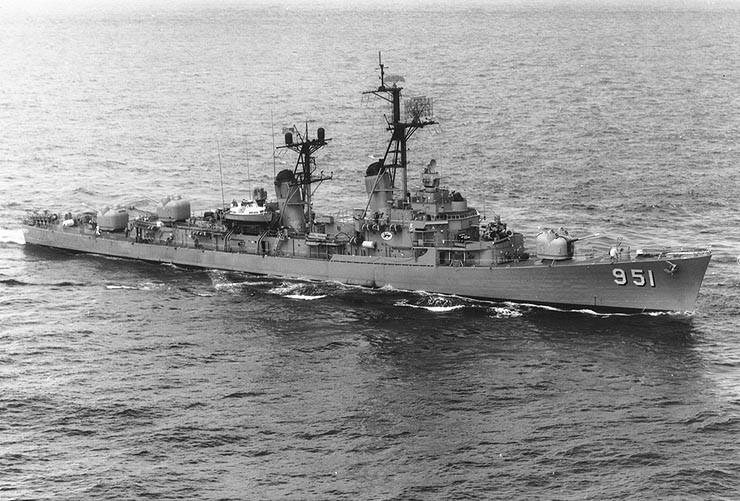 USS Turner Joy on 9 May 1964 in Vietnam
USS Turner Joy on 9 May 1964 in Vietnam
Early Service 1959-63
USS Turner Joy (named after Admiral Charles Turner Joy 1895–1956) was built by Puget Sound, Seattle, commissioned in Bremerton on 3 August 1959. She made a pre-shakedown goodwill cruise to Central and South America, proper shakedown off San Diego and flagship of DesRon 13, DesDiv 131 based at NS Long Beach. She started a serie of ASW exercises around USS Hornet until 17 May 1960, departing for the western Pacific via Pearl Harbor and Apra in Guam.
She was posted as plane guard in the Marianas as President Dwight D. Eisenhower flew in Asia. She stopped in Bangkok, Thailand and was present during the Chinese shelling of Quemoy and Matsu in Taiwan Strait, as part of the patrol. In August 1960 she operated with the 7th Fleet off Japan as part of her 1st WestPacific, resupplying at Yokosuka.
From November 1960 she was overhauled over 18 months before training with the 1st Fleet. From October 1961 she was assigned to DesRon 19 as flagship. On 2 June 1962, she trained with USS Hornet and took part in exercises with Amphibious Squadron 5 off Hawaii and screened USS Hancock off Honshū.
Her 2nd WestPac alternated operations in the Sea of Japan, east of Japan, South China Sea with notably USS Bon Homme Richard. After back home in June she spent the next 14 months in overhaul and returned with the 1st Fleet exercises until 1964.
USS Turner Joy in Vietnam
On 13 March 1964, she started her first tour of duty in Vietnam. She screened USS Kitty Hawk in the Philippine Sea, went into the South China Sea but by late July 1964, she was attached to TG USS Ticonderoga, for “watch dog” patrols off Vietnam. On 2 August 1964 USS Maddox, in a DESOTO patrol was attacked by three P 4-class torpedo boats from the NVA’s 135th Torpedo Squadron, and engaged them with her main guns, spending circa 280 rounds until contact was broken. The TBs were later spotted and attacked by F-8 Crusader from Ticonderoga by rockets and cannon fire. USS Turner Joy soon joined Maddox but the incident that opened the war was over.
On 3 August she took part in the DESOTO mission and the following day, picked up by radar a number of high-speed surface craft. They called Ticonderoga for air support. By nightfall and it was later confirmed the VPN torpedo boats were closing from the west and south. Turner Joy reported torpedo wakes and rushed at full speed, maneuvered and fired on the contacts, spending 220 shells, whereas aicraft were on the scene. The vessels retired, two sunk. However the aftermath was that radar and sonar were controversial to say the least on 4 August and after the war, this was confirmed by the absence of any attack from the Vietnamese that day. Admiral Sharpe notified “Freak weather effects on radar” at the time. The whole “incident” that trigerred the longest war of US history apparenty started with bogus radar blips and acute patranoia.
On 1- 2 July 1966, however VPN Torpedo Squadron 135’s T-333, T-336, and T-339 had indeed attacked USS Maddox and targeted more US destroyers but were deterred by the aviation of USS Constellation and Hancock. One that sunk had 19 sailors taken as POWs, demonstrated further the absence of attack on the 4th. USS Constellation soon joined USS Ticonderoga in Operation Pierce Arrow. Motor torpedo boat bases at Quang Khe and Phuc Loi and oil storage were flattened. The US Congress passed the Tonkin Gulf Resolution resulting in open warfare, and Turner Joy went on her deployment until back to Long Beach on 2 October. After a three-month overhaul, refresher training she departed with DesRon 19 and joined USS Coral Sea, acting as escort and detached as radar picket.
From 23 September, she took part of the gunline in the Gulf of Thailand, followed by upkeep at Subic Bay, then back, operating between Cape St. Jacques and Chu Lai. On 25 September however at the end of her mission a 5-inch round misfired but while trying to clear the chamber it detonated, killing three, wounding three. She was repaired in Subic Bay and returned to duty alongside USS Ticonderoga. In January 1966 she served at Yankee Station. In March-May back home she was overhauled and training and back to the Pacific on 11 June. On the west coast she participated in “Baseline II” and made her 3rd and then 4th deployments in Vietnam, between plaene guard duties and shore bombardment missions.
From March 1967 she shelled positons in North Vietnam and interdicted logistical efforts (Operation Sea Dragon). On 7 April off Cap Mui Ron she was targeted by a North Vietnamese shore battery, hit on her fantail and near-missed close to the forward mast, one round devastating her supply office and penetrated her ammunition stowage while wounding a member of the repair party, disabling her air-search radar. She however remained on station, replaced by HMAS Hobart on 16 April. After repairs in Subic Base, she sailed to Melbourne, stopping at Manus Island and Brisbane. Later she visited New Zealand and took part in the Coral Sea Battle celebration. Back home she went into upkeep at Puget Sound.
From March 1968 and for five months she was back in Vietnam, between naval gunfire support, “Sea Dragon” patrols. She was bac at Long Beach on 26 September and overhauled until February 1969. After 1st Fleet ASW/AAW exercises and her summer training cruise she departed in November for Vietnam, stopping at Midway and Guam. She operated from Danang in gunfire support and plane guard at Yankee Station with TF 77. In April 1969 she served with USS Shangri-La. The next year was near identical and she served as escort for PIRAZ (positive identification and radar advisory zone), later evading a typhoon in April. She made another PIRAZ in June and served with USS Kitty Hawk. She visited Australia and New Zealand and by late July rreturned home until late 1971.
Her 6th month overhaul followed, in which she receiced new 5 inch/54 gun mounts, overhauled propulsion to burn Navy distillate fuel and renovations from top to bottom. After arefresher training by December she returned at Subic Bay and returned to her last gunline mission, spending 10,000 in South Vietnam and North Vietnam until 28 January 1973, before the ceasefire. She practically was in Vietnam for the entire war, year after year, the longest and most intense Vietnam career of any US destroyer.
Post Vietnam career
She later took part in Operation End Sweep (minesweeping of Haiphong harbor) ASW and carrier operations and port visits (Hong Kong, Kaohsiung, Sasebo, Yokosuka) until back to Long Beach on 22 June, followed by upkeep and sailing to her new home port, NS San Diego.
From April 1974 she returned to her new WestPac, with USS Ranger off Oahu and visiting Surabaya until back to San Diego. 1975 was spent in overhaul and training off California followed by a tour in the western Pacific and the Indian Ocean with USS Midway, Fanning, Sacramento, reaching Bandar Abbas in Iran via Singapore and Sri Lanka. She took part in CENTO exercise “Midlink” with British, Iranian and Pakistani navies until 25 November. She was back in Subic Bay in December adn returned in the South China Sea later weatering a typhoon. On 17 March 1976 she departed for San Diego. She failed at her Operational Propulsion Plant Examination and spent 1976 in repairs.
By mid-1979 she returned to a Westpac/South Pac goodwill cruise between the Philippines, Hong Kong, Singapore, Australia, & New Zealand. 1982 saw her retirement announced and she was decommissioned on 22 November 1982, stricken on 13 February 1990 but acquired by the Bremerton Historic Ships Association. She was reopened to the public in 1992 in Bremerton as a museum ship. A second historical ship of the early cold war era to visit.

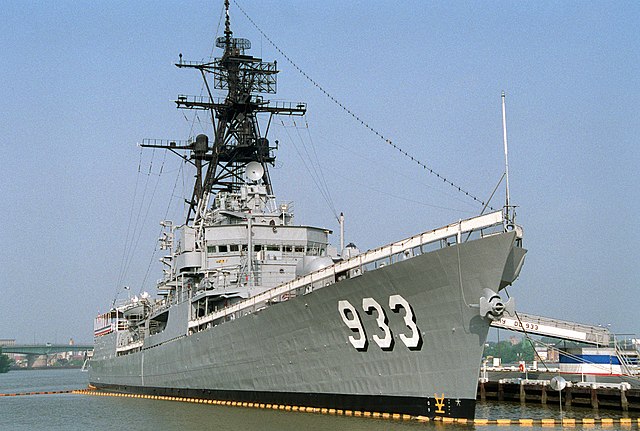

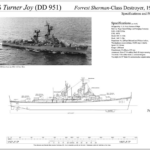
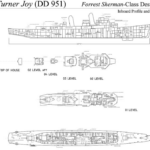

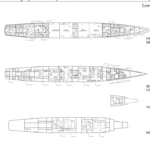
 Latest Facebook Entry -
Latest Facebook Entry -  X(Tweeter) Naval Encyclopedia's deck archive
X(Tweeter) Naval Encyclopedia's deck archive Instagram (@navalencyc)
Instagram (@navalencyc)





 French Navy
French Navy Royal Navy
Royal Navy Russian Navy
Russian Navy Armada Espanola
Armada Espanola Austrian Navy
Austrian Navy K.u.K. Kriegsmarine
K.u.K. Kriegsmarine Dansk Marine
Dansk Marine Nautiko Hellenon
Nautiko Hellenon Koninklije Marine 1870
Koninklije Marine 1870 Marinha do Brasil
Marinha do Brasil Osmanlı Donanması
Osmanlı Donanması Marina Do Peru
Marina Do Peru Marinha do Portugal
Marinha do Portugal Regia Marina 1870
Regia Marina 1870 Nihhon Kaigun 1870
Nihhon Kaigun 1870 Preußische Marine 1870
Preußische Marine 1870 Russkiy Flot 1870
Russkiy Flot 1870 Svenska marinen
Svenska marinen Søværnet
Søværnet Union Navy
Union Navy Confederate Navy
Confederate Navy Armada de Argentina
Armada de Argentina Imperial Chinese Navy
Imperial Chinese Navy Marinha do Portugal
Marinha do Portugal Mexico
Mexico Kaiserliche Marine
Kaiserliche Marine 1898 US Navy
1898 US Navy Sovietskiy Flot
Sovietskiy Flot Royal Canadian Navy
Royal Canadian Navy Royal Australian Navy
Royal Australian Navy RNZN Fleet
RNZN Fleet Chinese Navy 1937
Chinese Navy 1937 Kriegsmarine
Kriegsmarine Chilean Navy
Chilean Navy Danish Navy
Danish Navy Finnish Navy
Finnish Navy Hellenic Navy
Hellenic Navy Polish Navy
Polish Navy Romanian Navy
Romanian Navy Turkish Navy
Turkish Navy Royal Yugoslav Navy
Royal Yugoslav Navy Royal Thai Navy
Royal Thai Navy Minor Navies
Minor Navies Albania
Albania Austria
Austria Belgium
Belgium Columbia
Columbia Costa Rica
Costa Rica Cuba
Cuba Czechoslovakia
Czechoslovakia Dominican Republic
Dominican Republic Haiti
Haiti Hungary
Hungary Honduras
Honduras Estonia
Estonia Iceland
Iceland Eire
Eire Equador
Equador Iran
Iran Iraq
Iraq Latvia
Latvia Liberia
Liberia Lithuania
Lithuania Mandchukuo
Mandchukuo Morocco
Morocco Nicaragua
Nicaragua Persia
Persia San Salvador
San Salvador Sarawak
Sarawak Uruguay
Uruguay Venezuela
Venezuela Zanzibar
Zanzibar Warsaw Pact Navies
Warsaw Pact Navies Bulgaria
Bulgaria Hungary
Hungary

 Bundesmarine
Bundesmarine Dutch Navy
Dutch Navy Hellenic Navy
Hellenic Navy Marina Militare
Marina Militare Yugoslav Navy
Yugoslav Navy Chinese Navy
Chinese Navy Indian Navy
Indian Navy Indonesian Navy
Indonesian Navy JMSDF
JMSDF North Korean Navy
North Korean Navy Pakistani Navy
Pakistani Navy Philippines Navy
Philippines Navy ROKN
ROKN Rep. of Singapore Navy
Rep. of Singapore Navy Taiwanese Navy
Taiwanese Navy IDF Navy
IDF Navy Saudi Navy
Saudi Navy Royal New Zealand Navy
Royal New Zealand Navy Egyptian Navy
Egyptian Navy South African Navy
South African Navy






























 Ukrainian Navy
Ukrainian Navy dbodesign
dbodesign
Great write up!
Do you know where I could get plans for a DD-931 Class 2 gun ASW version?
Best regards,
Frank Dengler
Thx ! – Plans should be declassified so apart the library of congress, and check this one, although quite close to the Korea war: https://www.archives.gov/research/cartographic/ship-plans
Others: https://www.history.navy.mil/research/histories/ship-histories/sources-of-ship-plans.html and https://archive.org/details/ship-design-drawings
Good luck !